Blog
Cerebus re-read 2015–2017: Rick’s Story
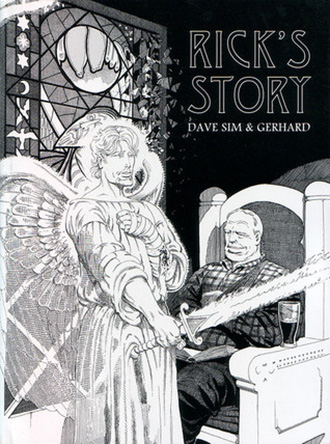 You remember Rick, right? Jaka’s husband? Well, he’s old and fat now, but it seems he’s had quite a life so far. As this volume opens, he and Cerebus are shooting the shit while Cerebus tends bar. It seems Rick is writing a book about his own life, called (you guessed it) “Rick’s Story.” While reading to Cerebus of his sexual exploits, both are having a great time and laughing their asses off, but we start to see cracks in Rick’s sanity. He hallucinates Cerebus as some kind of demon. He views Cerebus as a fallen pope, one who, on a spiritual level, seems to be trying to distract Rick from writing his story. That is, until Thatcher stops by on one of her routine supply dropoffs. You might recall that Rick had his finger broken on the orders of Thatcher after he struck Jaka for aborting their baby without telling him. As such, he (through the magic of insanity), sees her as a literal monster, and is terrified to the point of paralysis. Cerebus, having gotten Thatcher under his telepathic thumb last volume, sees this and deals her a mighty mind blow which manifests itself as a cartoonishly collapsed face (hilariously reversed by blowing on his fingers in the same way you might inflate a balloon). Well, this turns things around for Rick a bit. Cerebus is now a savior, and with his advice on how to deal with unwanted women by telling them “G’wan! Beat it! SCRAM!” Rick is a convert. However, he’s having some difficulty reconciling his two visions of Cerebus, so reality cracks just a bit more for ol’ Rick, and it’s about to get a lot worse.
You remember Rick, right? Jaka’s husband? Well, he’s old and fat now, but it seems he’s had quite a life so far. As this volume opens, he and Cerebus are shooting the shit while Cerebus tends bar. It seems Rick is writing a book about his own life, called (you guessed it) “Rick’s Story.” While reading to Cerebus of his sexual exploits, both are having a great time and laughing their asses off, but we start to see cracks in Rick’s sanity. He hallucinates Cerebus as some kind of demon. He views Cerebus as a fallen pope, one who, on a spiritual level, seems to be trying to distract Rick from writing his story. That is, until Thatcher stops by on one of her routine supply dropoffs. You might recall that Rick had his finger broken on the orders of Thatcher after he struck Jaka for aborting their baby without telling him. As such, he (through the magic of insanity), sees her as a literal monster, and is terrified to the point of paralysis. Cerebus, having gotten Thatcher under his telepathic thumb last volume, sees this and deals her a mighty mind blow which manifests itself as a cartoonishly collapsed face (hilariously reversed by blowing on his fingers in the same way you might inflate a balloon). Well, this turns things around for Rick a bit. Cerebus is now a savior, and with his advice on how to deal with unwanted women by telling them “G’wan! Beat it! SCRAM!” Rick is a convert. However, he’s having some difficulty reconciling his two visions of Cerebus, so reality cracks just a bit more for ol’ Rick, and it’s about to get a lot worse.
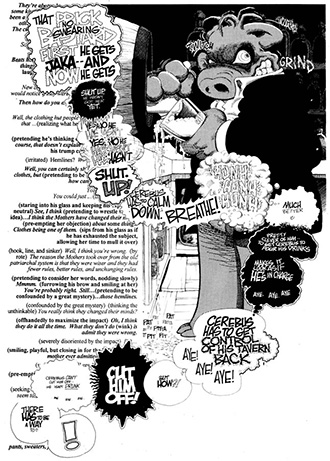 Who should return to the bar but Joanne? Hellbent on making Cerebus jealous after seeing Rick staying at the bar while hiding in the bushes, she makes her way in and begins flirting heavily with Rick. Cerebus is driven to a hardly contained jealous rage, as planned. She asks Rick if he’d like to go to the big bonfire that night. However, she stands him up, and Cerebus makes a case when he arrives back in the bar, dejected and with a cut on the side of his head, that most women aren’t to be trusted—that they are lunatics, vipers, and scorpions. Joanne comes to apologize, saying that her mother had a fever. This drives Cerebus into overdrive, trying to get Rick to see that she’s bad for him, that she’s lying to him completely (she is). She storms out and Rick gets drunk, telling Cerebus that he’ll follow him wherever he shall lead. Of course, this is contrary to Cerebus’ plans, especially since he’s trying to get up north to his hometown. He realizes he’d actually be much better off if Rick were to go with Joanne, and so switches his tactic a bit. Rick seems to understand, and it’s around here that we see the return of chunks of text in Cerebus. Rick abandons his own story and begins writing of the word of Cerebus in a parodic biblical style. Cerebus, meanwhile is back on his own crazy train, arguing with his multiple personalities about his advice to Rick.
Who should return to the bar but Joanne? Hellbent on making Cerebus jealous after seeing Rick staying at the bar while hiding in the bushes, she makes her way in and begins flirting heavily with Rick. Cerebus is driven to a hardly contained jealous rage, as planned. She asks Rick if he’d like to go to the big bonfire that night. However, she stands him up, and Cerebus makes a case when he arrives back in the bar, dejected and with a cut on the side of his head, that most women aren’t to be trusted—that they are lunatics, vipers, and scorpions. Joanne comes to apologize, saying that her mother had a fever. This drives Cerebus into overdrive, trying to get Rick to see that she’s bad for him, that she’s lying to him completely (she is). She storms out and Rick gets drunk, telling Cerebus that he’ll follow him wherever he shall lead. Of course, this is contrary to Cerebus’ plans, especially since he’s trying to get up north to his hometown. He realizes he’d actually be much better off if Rick were to go with Joanne, and so switches his tactic a bit. Rick seems to understand, and it’s around here that we see the return of chunks of text in Cerebus. Rick abandons his own story and begins writing of the word of Cerebus in a parodic biblical style. Cerebus, meanwhile is back on his own crazy train, arguing with his multiple personalities about his advice to Rick.
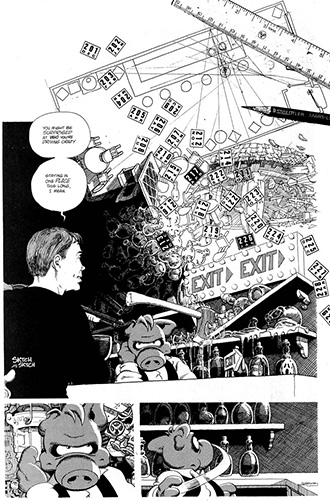 After Cerebus has given Rick his “blessing” to date Joanne, he does so, but comes back quite early. Cerebus lambastes him for this, as it turns out Joanne was there hanging out with a male friend of hers that was alluded to in Guys and who caused Cerebus some jealousy. Rick, having thought it was a date and not just a group hangout, stayed for a while, but got up to leave shortly thereafter, mentioning that it seemed the two had a lot to talk about. Cerebus chides Rick and says that it now looks as though he was jealous. Joanne suddenly appears at the door seething with rage, demanding to know why Rick took off. Rick, smiling and answering in a cheerful, sing-song voice (advice from earlier in the book about how to keep a girlfriend), states that he wasn’t sure about the nature of the meetup, and suggests the two go for a walk. Later that night (after tons of scotch), Cerebus awakens to the sound of the two returning to the bar and making love, a sound which is music to Cerebus’ ears, as he can now go home. The next morning, Rick comes downstairs in a decidedly serious mood. He speaks cryptically, but it soon becomes clear that he is performing a binding spell on Cerebus and the bar. He leaves after telling Cerebus that they’ll see each other only once more after this, and then saying “I’m going to tell you exactly what I told Joanne. Go to hell.” Cerebus is sad for a moment but realizes he’s now free to go home. After some strange physical effects of the binding spell, Cerebus has some indecision about whether to leave, worried about whether the spell was meant to make him stay or go. Defeated, and realizing that he can die alone, unmourned and unloved just as well in the bar as he can in his hometown, he returns to the bar to find Dave sitting there. There’s a text with pictures discussion in which Dave flexes his creator muscles, causing Cerebus to forget Dave’s order multiple times, and seems to be trying to lead Cerebus to some self-reflection. He disappears while Cerebus has his back turned and just then realizes who he’s speaking to. When he wheels back around, he sees only a package on the bar. Upon opening it, he finds Jaka’s doll, Missy (left behind during Women, remember?). The moment the package is open, Jaka walks through the door.
After Cerebus has given Rick his “blessing” to date Joanne, he does so, but comes back quite early. Cerebus lambastes him for this, as it turns out Joanne was there hanging out with a male friend of hers that was alluded to in Guys and who caused Cerebus some jealousy. Rick, having thought it was a date and not just a group hangout, stayed for a while, but got up to leave shortly thereafter, mentioning that it seemed the two had a lot to talk about. Cerebus chides Rick and says that it now looks as though he was jealous. Joanne suddenly appears at the door seething with rage, demanding to know why Rick took off. Rick, smiling and answering in a cheerful, sing-song voice (advice from earlier in the book about how to keep a girlfriend), states that he wasn’t sure about the nature of the meetup, and suggests the two go for a walk. Later that night (after tons of scotch), Cerebus awakens to the sound of the two returning to the bar and making love, a sound which is music to Cerebus’ ears, as he can now go home. The next morning, Rick comes downstairs in a decidedly serious mood. He speaks cryptically, but it soon becomes clear that he is performing a binding spell on Cerebus and the bar. He leaves after telling Cerebus that they’ll see each other only once more after this, and then saying “I’m going to tell you exactly what I told Joanne. Go to hell.” Cerebus is sad for a moment but realizes he’s now free to go home. After some strange physical effects of the binding spell, Cerebus has some indecision about whether to leave, worried about whether the spell was meant to make him stay or go. Defeated, and realizing that he can die alone, unmourned and unloved just as well in the bar as he can in his hometown, he returns to the bar to find Dave sitting there. There’s a text with pictures discussion in which Dave flexes his creator muscles, causing Cerebus to forget Dave’s order multiple times, and seems to be trying to lead Cerebus to some self-reflection. He disappears while Cerebus has his back turned and just then realizes who he’s speaking to. When he wheels back around, he sees only a package on the bar. Upon opening it, he finds Jaka’s doll, Missy (left behind during Women, remember?). The moment the package is open, Jaka walks through the door.
She rushes to embrace him, and the two spend the night flirting while Cerebus serves wine and attends to his duties. The two go upstairs to make love for the first time since they first met in issue #6. The next morning, she eats breakfast at the bar (significantly moving an object from Rick’s binding spell out of her way). Suddenly, the door opens (it seems the only people that ever come around are hugely significant), and in walks Bear, Marty, and former bartender Richard George, fresh out of their respective relationships and ready to get hammered (moving the other three binding spell objects as they sit). Cerebus is thrilled, and begins serving them while they begin a game of cards and crack rude jokes. Bear, of course, recognizes Jaka from his interaction with her in Church & State, and seems dismissive of her, having returned to his viewpoint that men are better off without women. He makes one particularly crude joke at women’s expense, and an angry Jaka gets up from her stool to leave. She calls to Cerebus (“like she asked me a question? and I wasn’t answering fast enough?”—Rick’s recounting of his time with Jaka) and then leaves without saying another word. Cerebus stands, uncertain, then tells Bear to take care of himself. Bear grins and wishes him good fuckin’ luck as he runs after Jaka. He’s gonna—wattayacall—need it.
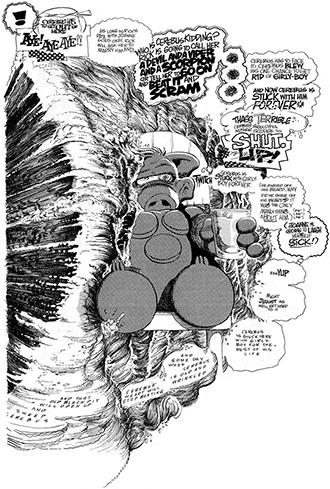 This is the volume that changed Dave’s life fairly drastically. As I recall, he had mostly put his partying days behind him, but was still what he would call an athiest and fornicator. Rick’s Story was originally meant to be a parody of the bible, and indeed, it still is, especially in the context of the ridiculous origins of religion (I wonder if Jesus was also 3 feet tall and gray). In doing research for the text sections of the book, Dave was reading the bible itself to understand its tone, and in doing so, came away with the belief that the bible really is the word of god. His personal religion has since come to combine Judaism and Islam, but at the time he was apparently rocked pretty hard by Christianity, and that set him on the path that he’s on now—a pretty religiously dedicated fellow who prays multiple times a day and fasts on (I think) Sundays. A guy who has done public readings from the King James version of the bible. This guy, who was once an avowed atheist, womanizer, alcohol-imbibing, drug-taking, party animal. Pretty shocking, right? It’s going to come into play in Cerebus big-time coming up. The sections of the book that take direct influence from the bible are fairly funny, but are kind of hard to read. Besides the flowery bible-type language, all the “v’s” are “u’s,” etc. It’s not a major turn-off as it’s a pretty small portion of the book, but it doesn’t make for fluid reading.
This is the volume that changed Dave’s life fairly drastically. As I recall, he had mostly put his partying days behind him, but was still what he would call an athiest and fornicator. Rick’s Story was originally meant to be a parody of the bible, and indeed, it still is, especially in the context of the ridiculous origins of religion (I wonder if Jesus was also 3 feet tall and gray). In doing research for the text sections of the book, Dave was reading the bible itself to understand its tone, and in doing so, came away with the belief that the bible really is the word of god. His personal religion has since come to combine Judaism and Islam, but at the time he was apparently rocked pretty hard by Christianity, and that set him on the path that he’s on now—a pretty religiously dedicated fellow who prays multiple times a day and fasts on (I think) Sundays. A guy who has done public readings from the King James version of the bible. This guy, who was once an avowed atheist, womanizer, alcohol-imbibing, drug-taking, party animal. Pretty shocking, right? It’s going to come into play in Cerebus big-time coming up. The sections of the book that take direct influence from the bible are fairly funny, but are kind of hard to read. Besides the flowery bible-type language, all the “v’s” are “u’s,” etc. It’s not a major turn-off as it’s a pretty small portion of the book, but it doesn’t make for fluid reading.
Dave declares emphatically that Rick is not a Sim avatar, though there are a few parallels that make it understandable that someone might think that. Rick is turned from his life of debauchery by the word of god, and he also seems to be fairly schizophrenic (Dave having been diagnosed as only borderline, of course), and then there’s the matter of his changed opinion on women. I tend to take Dave at his word because there’s usually nothing for him to gain by lying, so if Rick is not a representation of Dave, he’s certainly a kindred spirit.
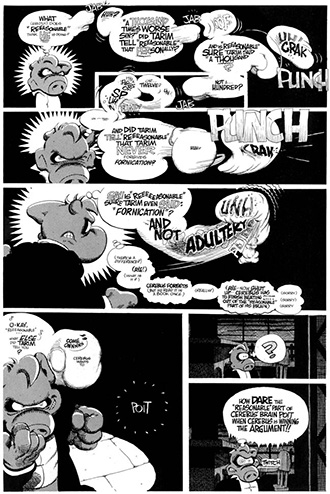 Artwise, this is definitely one of my favorite volumes. The lettering alone is staggering in its ability to directly inject voices into the reader’s head. There’s no ambiguity about the cadence and tone of anyone’s speech here—it’s the most masterful and natural dialogue I’ve ever read. And the paneling! Sweet lord. You really get a sense of what it might be like to be affected by schizophrenia. Multiple perceptions of reality converge or are separated depending on the paneling, and it all leaves the reader a little dizzy, a virtue for this kind of thing. Gerhard continues to be great, but he’s been drawing the same tavern for over two years now, so there’s not much new to talk about on his side. Especially since the volume features mostly close-ups. I think he must have brokered a deal with Dave so he wouldn’t have to draw the tavern too much. In addition, Dave’s style has gotten quite a bit rounder, even since the last volume. This is most drastically displayed in his drawing of Thatcher, and within that parameter, there’s one panel in particular after her face has been re-inflated that she almost looks to be made from marshmallows or something. A far cry from the rather severe and somewhat angular Thatcher of Jaka’s Story. I know Dave began drawing Cerebus rounder over the years as it was quicker to draw a few circles for his head and snout rather than cylinders or even ovals, so this is probably more of the same. Gerhard was by this time working at home, I believe, and it seems to me there was a sense of just finding shortcuts and trying to get through to 300. I wonder if Dave was regretting having only joked about ending at 200 rather than really meaning it way back in Reads. This has truly been the epilogue to Cerebus’ adventures—the dumb little aardvark existing in stasis, not doing much of anything other than talking to himself and inadvertently starting a religion. It’s always funny, of course, but you can’t say much is really happening to the guy. Well, yet.
Artwise, this is definitely one of my favorite volumes. The lettering alone is staggering in its ability to directly inject voices into the reader’s head. There’s no ambiguity about the cadence and tone of anyone’s speech here—it’s the most masterful and natural dialogue I’ve ever read. And the paneling! Sweet lord. You really get a sense of what it might be like to be affected by schizophrenia. Multiple perceptions of reality converge or are separated depending on the paneling, and it all leaves the reader a little dizzy, a virtue for this kind of thing. Gerhard continues to be great, but he’s been drawing the same tavern for over two years now, so there’s not much new to talk about on his side. Especially since the volume features mostly close-ups. I think he must have brokered a deal with Dave so he wouldn’t have to draw the tavern too much. In addition, Dave’s style has gotten quite a bit rounder, even since the last volume. This is most drastically displayed in his drawing of Thatcher, and within that parameter, there’s one panel in particular after her face has been re-inflated that she almost looks to be made from marshmallows or something. A far cry from the rather severe and somewhat angular Thatcher of Jaka’s Story. I know Dave began drawing Cerebus rounder over the years as it was quicker to draw a few circles for his head and snout rather than cylinders or even ovals, so this is probably more of the same. Gerhard was by this time working at home, I believe, and it seems to me there was a sense of just finding shortcuts and trying to get through to 300. I wonder if Dave was regretting having only joked about ending at 200 rather than really meaning it way back in Reads. This has truly been the epilogue to Cerebus’ adventures—the dumb little aardvark existing in stasis, not doing much of anything other than talking to himself and inadvertently starting a religion. It’s always funny, of course, but you can’t say much is really happening to the guy. Well, yet.
Top Moments
Cerebus’ twitching, grinding jealousy
“Duds?”
Cerebus’ reaction to Rick asking Joanne to go for a walk
“You might be surprised at who you’re driving crazy. Staying in one place this long, I mean.”
“Dave probably doesn’t want to kill Cerebus off. But…what CHOICE does he have? To tell his boss ‘NO! I WON’T kill Cerebus off—I QUIT!’? Dave probably has a wife and kids to support. House payments. Groceries. A LOT of expenses.”
Cerebus re-read 2015–2017: Guys
 After the major events and revelations of the Mothers & Daughters storyline, Guys is a definite breather. It’s a relaxing, fun read that’s hard to put down, but is also full of insight and relationships that ring very true in the real world—at least to this reviewer. It’s also the funniest that Cerebus has been in many volumes. With no action to speak of, the book is carried handily by Dave’s fine-tuned comedic timing and storytelling (although there’s not even much of a story until the last third). Because of its humor, this volume consistently makes it into longtime fans’ top 3, and I think it’s there for me, too. The bonus of a volume that doesn’t feature much action is that I don’t have to undertake a laborious recounting of the story. To quote Homer Simpson, “it’s just a bunch of stuff that happened.”
After the major events and revelations of the Mothers & Daughters storyline, Guys is a definite breather. It’s a relaxing, fun read that’s hard to put down, but is also full of insight and relationships that ring very true in the real world—at least to this reviewer. It’s also the funniest that Cerebus has been in many volumes. With no action to speak of, the book is carried handily by Dave’s fine-tuned comedic timing and storytelling (although there’s not even much of a story until the last third). Because of its humor, this volume consistently makes it into longtime fans’ top 3, and I think it’s there for me, too. The bonus of a volume that doesn’t feature much action is that I don’t have to undertake a laborious recounting of the story. To quote Homer Simpson, “it’s just a bunch of stuff that happened.”
 As the book begins, it turns out Dave was as good as his word, and we open on Cerebus hanging out in the little tavern by the Castle Wallis, at the Wall of Tsi. It’s not clear how long he’s been there at this point, but it’s certainly long enough that the bartenders (either Harrison Starkey or Richard George—identical Beatles parodies both) have become familiar with Cerebus’ drinking habits, which aren’t so much habits as a lifestyle at this point. Buckets of scotch will do that to an aardvark. With the Cirinist rule that unmarried men must live in an assigned tavern until they are either ready to settle down, or drink themselves to death, the choice is obvious for many. Among the other denizens of the bar are Cerebus’ old merc buddies (and former employees from his time as pope), Bear and Boobah. Boobah has put on some middle-age weight around the midsection, foreshadowing an underlying theme of the book; what happens to us as we age. Mick and Keef are there too, their marriage to the Buttock sisters clearly having not worked out. Perhaps the most popular (to readers, not to the characters) fellow at the tavern is Marty, a representation of Marty Feldman (starting out as a parody of the Martin Humble character from Starchild), who has somehow over the course of his life worked in every conceivable field. He wastes no time in using this dubious experience to dole out advice and expertise, Cliff Claven-like, on his fellow barflies. A version of comic artist Eddie Campbell and his creation Bacchus, are also there, as well as a number of other comic parodies. The book is rife with these allusions, parodies, and homages to the history of comics. There’s even an Al Hirschfeld/Norman Mailer mashup! These zany characters basically spend the first two-thirds of the book getting hammered every day, shooting the shit, arguing, and playing pranks on one another, as indeed you might if you were trapped in a tavern for the rest of your life.
As the book begins, it turns out Dave was as good as his word, and we open on Cerebus hanging out in the little tavern by the Castle Wallis, at the Wall of Tsi. It’s not clear how long he’s been there at this point, but it’s certainly long enough that the bartenders (either Harrison Starkey or Richard George—identical Beatles parodies both) have become familiar with Cerebus’ drinking habits, which aren’t so much habits as a lifestyle at this point. Buckets of scotch will do that to an aardvark. With the Cirinist rule that unmarried men must live in an assigned tavern until they are either ready to settle down, or drink themselves to death, the choice is obvious for many. Among the other denizens of the bar are Cerebus’ old merc buddies (and former employees from his time as pope), Bear and Boobah. Boobah has put on some middle-age weight around the midsection, foreshadowing an underlying theme of the book; what happens to us as we age. Mick and Keef are there too, their marriage to the Buttock sisters clearly having not worked out. Perhaps the most popular (to readers, not to the characters) fellow at the tavern is Marty, a representation of Marty Feldman (starting out as a parody of the Martin Humble character from Starchild), who has somehow over the course of his life worked in every conceivable field. He wastes no time in using this dubious experience to dole out advice and expertise, Cliff Claven-like, on his fellow barflies. A version of comic artist Eddie Campbell and his creation Bacchus, are also there, as well as a number of other comic parodies. The book is rife with these allusions, parodies, and homages to the history of comics. There’s even an Al Hirschfeld/Norman Mailer mashup! These zany characters basically spend the first two-thirds of the book getting hammered every day, shooting the shit, arguing, and playing pranks on one another, as indeed you might if you were trapped in a tavern for the rest of your life.
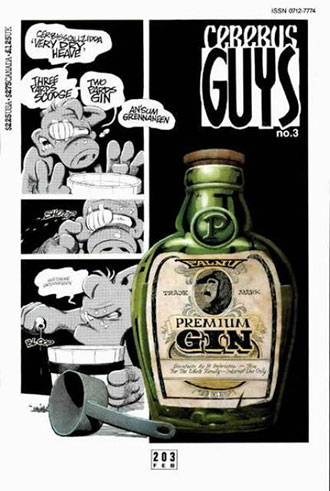 This isn’t going quite as well for Cerebus. We’ve seen him pretty drunk before, but he’s reaching supernatural levels of inebriation in this volume. As a result, he has NOT been as good as his word, and is not perceived as “very warm.” He spends much of the volume going into the red with any goodwill anybody might have shown him. In one notable scene, Bear really lays into him in one of the finest verbal takedowns in comics history. He chews Cerebus out for what he calls “chick shit”—getting emotionally distressed when people don’t react the way he expects them to. But there’s also good times, as there tends to be over the years. And the years do pass. Ger displays it through the changing of the seasons, Dave through the graying hair and expanding waistlines of his characters. In one scene that always sticks out to me because of my initial misunderstanding of it, Bear (grayer around the beard) and Cerebus are sunning themselves in silence on the riverbank when Bear suddenly says “hey, remember…’jobs?'” They both crack up, the joke being that despite the fact that they’re basically serving a prison sentence, it’s a damn sight better than working for a living. My misunderstanding was that, because of Dave’s volume titles (Reads, Minds, Guys, “Jobs”), I erroneously thought that it was some lost Cerebus storyline that I had either missed or that would be revealed in a flashback some time.
This isn’t going quite as well for Cerebus. We’ve seen him pretty drunk before, but he’s reaching supernatural levels of inebriation in this volume. As a result, he has NOT been as good as his word, and is not perceived as “very warm.” He spends much of the volume going into the red with any goodwill anybody might have shown him. In one notable scene, Bear really lays into him in one of the finest verbal takedowns in comics history. He chews Cerebus out for what he calls “chick shit”—getting emotionally distressed when people don’t react the way he expects them to. But there’s also good times, as there tends to be over the years. And the years do pass. Ger displays it through the changing of the seasons, Dave through the graying hair and expanding waistlines of his characters. In one scene that always sticks out to me because of my initial misunderstanding of it, Bear (grayer around the beard) and Cerebus are sunning themselves in silence on the riverbank when Bear suddenly says “hey, remember…’jobs?'” They both crack up, the joke being that despite the fact that they’re basically serving a prison sentence, it’s a damn sight better than working for a living. My misunderstanding was that, because of Dave’s volume titles (Reads, Minds, Guys, “Jobs”), I erroneously thought that it was some lost Cerebus storyline that I had either missed or that would be revealed in a flashback some time.
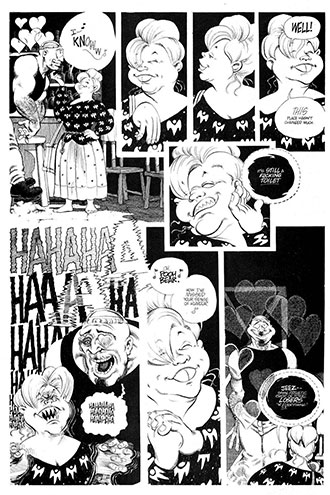 About two thirds through, a woman shows up at the door of the tavern. All the long-timers do a facepalm (“oh shit”) while Bear is cartoonishly hypnotized. This woman, Ziggy (“Zigpig” to the tavern denizens), has had some history with Bear. She is clearly an atrocious woman—demanding, manipulative, and owner of a laugh that could make you jump off a cliff—but Bear is under the spell of what’s under her skirt. The two go upstairs, and the rest of the crew begins making plans to head south, not wanting to stick around for the emotional slaughter to come. Cerebus takes great exception to this, but it’s no use. The next morning, Bear says he’s leaving with Zig, and Cerebus is alone. He’s decided to take over running the tavern and positions himself behind the bar. Thatcher shows up (the bar is under her jurisdiction) and begins to berate Cerebus for not wearing his uniform correctly. He lets loose on her with some heavy telepathy. It seems one benefit of being a hermaphrodite is that you can fight the Cirinists on their terms. He mentally biffs Thatcher so hard that she now bows to his every whim. Time passes. Unexpectedly, he’s visited by none other than Joanne, his mistress from Dave’s scenario in Minds. There’s a vague sensation that they know one another—Cerebus having a clearer memory than Joanne.
About two thirds through, a woman shows up at the door of the tavern. All the long-timers do a facepalm (“oh shit”) while Bear is cartoonishly hypnotized. This woman, Ziggy (“Zigpig” to the tavern denizens), has had some history with Bear. She is clearly an atrocious woman—demanding, manipulative, and owner of a laugh that could make you jump off a cliff—but Bear is under the spell of what’s under her skirt. The two go upstairs, and the rest of the crew begins making plans to head south, not wanting to stick around for the emotional slaughter to come. Cerebus takes great exception to this, but it’s no use. The next morning, Bear says he’s leaving with Zig, and Cerebus is alone. He’s decided to take over running the tavern and positions himself behind the bar. Thatcher shows up (the bar is under her jurisdiction) and begins to berate Cerebus for not wearing his uniform correctly. He lets loose on her with some heavy telepathy. It seems one benefit of being a hermaphrodite is that you can fight the Cirinists on their terms. He mentally biffs Thatcher so hard that she now bows to his every whim. Time passes. Unexpectedly, he’s visited by none other than Joanne, his mistress from Dave’s scenario in Minds. There’s a vague sensation that they know one another—Cerebus having a clearer memory than Joanne. 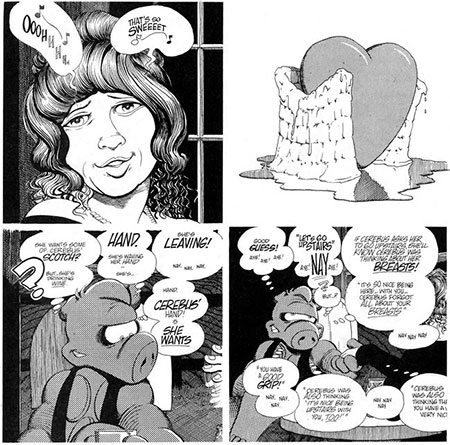 There begins a flirtation, and then a relationship. What follows is one of the funnier and more insightful aspects of the entire 300 issues, what it’s like to be in a relationship, with all the day-to-day roller coastering that usually gets left out of stories, in addition to Cerebus’ hilarious (and expertly lettered) internal arguments. Joanne is guarded, having been hurt in the past, but slowly begins to open her heart to Cerebus, who is basically playing a part, acting, almost, and doing what he’s been advised keeps women around (“be happy and you’ve got her as long as you want her”). What Joanne doesn’t know is that Cerebus has given Bear X number of days to return to the tavern, at which point Cerebus is going to head north to Sand Hills Creek, his birthplace, to see his parents. Joanne finds out about this and storms out. Then (I’m sensing a pattern here), another vaguely familiar face enters the bar. He’s middle aged, robust, and bearded. He teaches Cerebus how to pour a draught that’s not 90% head, then reveals himself as Jaka’s ex-husband, Rick.
There begins a flirtation, and then a relationship. What follows is one of the funnier and more insightful aspects of the entire 300 issues, what it’s like to be in a relationship, with all the day-to-day roller coastering that usually gets left out of stories, in addition to Cerebus’ hilarious (and expertly lettered) internal arguments. Joanne is guarded, having been hurt in the past, but slowly begins to open her heart to Cerebus, who is basically playing a part, acting, almost, and doing what he’s been advised keeps women around (“be happy and you’ve got her as long as you want her”). What Joanne doesn’t know is that Cerebus has given Bear X number of days to return to the tavern, at which point Cerebus is going to head north to Sand Hills Creek, his birthplace, to see his parents. Joanne finds out about this and storms out. Then (I’m sensing a pattern here), another vaguely familiar face enters the bar. He’s middle aged, robust, and bearded. He teaches Cerebus how to pour a draught that’s not 90% head, then reveals himself as Jaka’s ex-husband, Rick.
I know Dave meant the living situation depicted in this book to be negative, but I can’t help but read it thinking, “not too shabby.” Who wouldn’t want to live their days in leisure, with no employment obligations, and unlimited free time to socialize, read, play games, and get hammered? I guess it says something about my nature that I reacted this way—I hate obligation and live for absolute freedom from time. I’ll never get it, of course, which is why this book appeals to me. Life, eh?
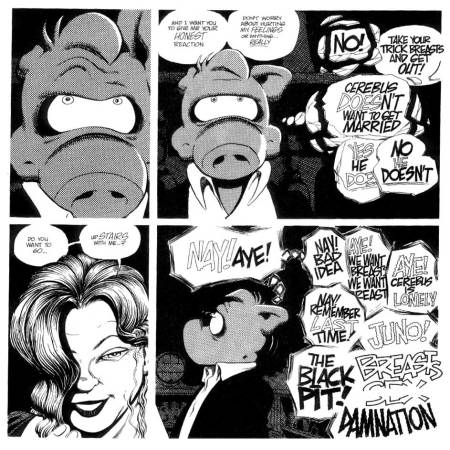 The art in this book is really fun. Dave gets a chance to not only parody characters, but to flex his chops in approximating the styles of Eddie Campbell, Al Hirschfeld, Shannon Wheeler, etc. It adds a strange incongruence to the setting, which sits nicely with Cerebus’ perpetual drunkenness and periodic hallucinations.It also helps pump up the humor with its cartoonish wackiness.The aforementioned internal arguments are also fantastic. The word balloons work as framing devices for panels, but they also look very physical, as if they were real—and to Cerebus, they surely are. There will be more of these in the next volume, and they really crank it up. Ger, on the other hand, was stuck drawing the same building for 19 issues. I imagine he felt as cooped up as the fellas, but his work is immaculate as usual. Another fun bit is that for the first time, the covers also work as part of the story. The dialogue and art leads right into the first page, and usually features some humorous Palnu-distilled liquor bottle.
The art in this book is really fun. Dave gets a chance to not only parody characters, but to flex his chops in approximating the styles of Eddie Campbell, Al Hirschfeld, Shannon Wheeler, etc. It adds a strange incongruence to the setting, which sits nicely with Cerebus’ perpetual drunkenness and periodic hallucinations.It also helps pump up the humor with its cartoonish wackiness.The aforementioned internal arguments are also fantastic. The word balloons work as framing devices for panels, but they also look very physical, as if they were real—and to Cerebus, they surely are. There will be more of these in the next volume, and they really crank it up. Ger, on the other hand, was stuck drawing the same building for 19 issues. I imagine he felt as cooped up as the fellas, but his work is immaculate as usual. Another fun bit is that for the first time, the covers also work as part of the story. The dialogue and art leads right into the first page, and usually features some humorous Palnu-distilled liquor bottle.
Cerebus has changed a fair amount over the years. Where he was once a fairly resourceful, cunning, and self-realized character, he has become petty, childish, and insecure. Is this a subconscious response to Dave’s revelations and his time on Juno? Or is it a result of his all-consuming “love” for Jaka? Coming back to a theme of Reads, that depicts women/relationships as being creative soulsuckers, has Cerebus lost himself in his mad desire for that which he cannot have? Bear, instead, is the voice of reason in this volume, and the truly balanced character (until Ziggy shows up, of course—lending weight to the latter theory above). In his introduction in Church & State, we saw Bear as a loyal, if perhaps dimwitted underling of Cerebus. But it turns out that Cerebus is actually in the lower position when he doesn’t have any gold, perhaps even looking up to Bear as an older brother type. We see a bit of this in a flashback at the end of Melmoth, and throughout this book. Cerebus is in a state of arrested development, and is often in awe of Bear’s experience and wisdom. Hell, it’s because of Bear that he even sticks around in the bar, hoping that his buddy will return. Of course he doesn’t, and we get Rick’s Story instead.
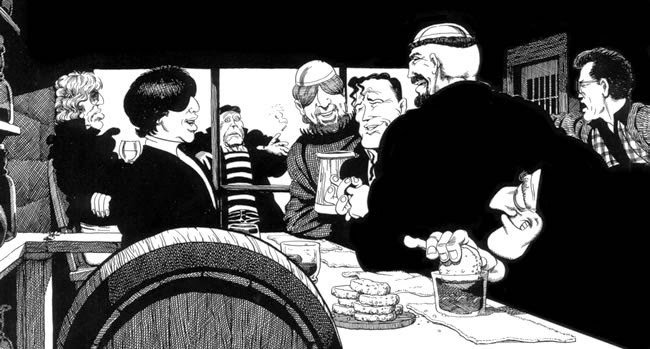
Cerebus re-read 2015–2017: Minds
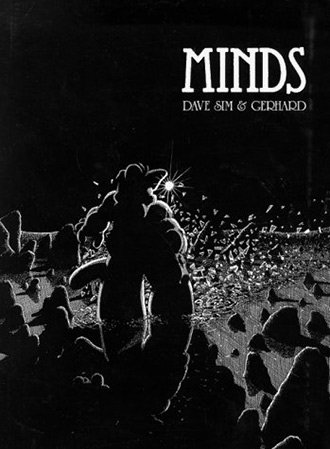 This volume has a particular resonance for me because I was just old enough to jump on the Cerebus train right toward the end of it. I remember flipping through it on the racks and thinking of how cool Cirin looked. Little did I know at the time (I was still getting through the first few phonebooks) that this section was perhaps the most important part of the entire story, and also the de facto conclusion of it. More on that later. There’s a lot to unpack with this volume, so I’m going to try to streamline it.
This volume has a particular resonance for me because I was just old enough to jump on the Cerebus train right toward the end of it. I remember flipping through it on the racks and thinking of how cool Cirin looked. Little did I know at the time (I was still getting through the first few phonebooks) that this section was perhaps the most important part of the entire story, and also the de facto conclusion of it. More on that later. There’s a lot to unpack with this volume, so I’m going to try to streamline it.
When we last saw Cerebus and Cirin, they were flying past the moon on a chunk of the Eastern Church (papal throne included). They’ve now begun fighting over whose god is real, Cerebus’ male “Tarim,” or Cirin’s female “Terim.” Cirin continues to accuse Cerebus of being an Illusionist (as if he would have the discipline for that), and they begin to physically fight over the throne. An asteroid sneaks up on them and smashes the throne, leaving only the block it stood on, which shortly breaks in two, sending Cerebus and Cirin in separate directions. Cerebus, now completely alone, begins to remember moments in his life (however, the reader gets the sense that he may be getting “shown” these moments, rather than truly remembering them—why else would he suddenly be reminded?), the events of which seem to him to be proof that Tarim does exist. It’s quite humorous that he would fight Cirin so vehemently over something he wasn’t sure of at the time, but that’s our aardvark. One incident involved young Cerebus praying after a serious injury that if Tarim makes everything ok, young Cerebus will never do another bad thing again. Another incident is pretty interesting in the mythology of the series. Cerebus’ father is speaking to Magus Doran, local magician. Apparently, young Cerebus had been going around town claiming himself to be the chosen one, so his father wanted Doran to instill some discipline in him magically. Doran replies, “And what if your son is correct? What if he is the chosen one?” and takes him on as an apprentice—a part of Cerebus’ life referenced only in passing until now. Cerebus, now sure that Tarim does exist, pledges complete loyalty, promising to conquer lands in his name and so on. A couple of frightening cosmological incidents then take place, paired with memories of times that Cerebus had cursed Tarim’s name (when he thought Jaka was dead) or was afraid of him (as a young aardvark in church), which cause him to beg forgiveness pretty humorously. At this point, a pie is flung into Cerebus’ face, seemingly from nowhere.
 A voice begins speaking to Cerebus from inside his head. It uses Cerebus’ perception of reality against him, along with some verbal gymnastics, to make him question his sanity, before finally revealing itself as Dave, Cerebus’ creator. That’s right, Dave Sim enters the comic (well, as a voice in Cerebus’ head) and reveals himself to his creation. He talks a bit about what it means to be a creator (the fact that he can’t really control how Cerebus reacts to situations) before trying to get Cerebus to reflect on his life and take some responsibility for his own happiness (“you’re the baker and your life is the bread”). He points out that Jaka doesn’t actually love him, and that she is held in Cerebus’ mind as some kind of ultimate cure for his unhappiness—he shows Cerebus a bit of her internal life to prove that Cerebus doesn’t really know her, he just places her on a pedestal as some kind of panacea for his misery.
A voice begins speaking to Cerebus from inside his head. It uses Cerebus’ perception of reality against him, along with some verbal gymnastics, to make him question his sanity, before finally revealing itself as Dave, Cerebus’ creator. That’s right, Dave Sim enters the comic (well, as a voice in Cerebus’ head) and reveals himself to his creation. He talks a bit about what it means to be a creator (the fact that he can’t really control how Cerebus reacts to situations) before trying to get Cerebus to reflect on his life and take some responsibility for his own happiness (“you’re the baker and your life is the bread”). He points out that Jaka doesn’t actually love him, and that she is held in Cerebus’ mind as some kind of ultimate cure for his unhappiness—he shows Cerebus a bit of her internal life to prove that Cerebus doesn’t really know her, he just places her on a pedestal as some kind of panacea for his misery.
He then brings Cirin close enough to illustrate her reaction to him telling her story, in which it’s revealed that she isn’t actually Cirin at all, but rather, Serna. It turns out Cirin was actually another woman with whom the beginnings of Cirinism were planned, and who was usurped and replaced by Serna the aardvark (who even stole her name). Cirin (the current one) makes it emphatically clear that she views this as a pack of lies. As a way of calming her, Dave “whispers” in Cirin’s ear that Cerebus’ reproductive system was irrevocably damaged in the childhood injury mentioned previously, which relieves Cirin to the point of euphoria. Her only interest in Cerebus was whether he could produce an aardvark offspring, and now that she knows he cannot, he doesn’t really exist to her.
 Dave finally allows Cerebus to ask him questions, the first of which is about the true nature of his medallions. Dave reveals that had he had them in his possession along with his sword and helmet at the time he met the Pigts, his life would have magically taken a dramatically different turn (literally). He would have the conquest he had long desired, all powered by three magical objects and a clay aardvark statue. You’d think this would be pretty galling to a guy like Cerebus, but still all he can think about is Jaka. He pushes that Dave could MAKE Jaka love him, and so he convinces Dave to set up a reality (narrated by Dave) in which he has married Jaka and things are going swimmingly. Unfortunately, a new neighbor, Joanne, has moved in and catches Cerebus’ eye. Cerebus lusts after her like crazy as they spend the hot summer days flirting while Jaka and Fred (Joanne’s husband) are at work. Eventually this destroys Cerebus’ marriage in a particularly horrifying way, just as Dave (back in the real world) drops him off on Pluto.
Dave finally allows Cerebus to ask him questions, the first of which is about the true nature of his medallions. Dave reveals that had he had them in his possession along with his sword and helmet at the time he met the Pigts, his life would have magically taken a dramatically different turn (literally). He would have the conquest he had long desired, all powered by three magical objects and a clay aardvark statue. You’d think this would be pretty galling to a guy like Cerebus, but still all he can think about is Jaka. He pushes that Dave could MAKE Jaka love him, and so he convinces Dave to set up a reality (narrated by Dave) in which he has married Jaka and things are going swimmingly. Unfortunately, a new neighbor, Joanne, has moved in and catches Cerebus’ eye. Cerebus lusts after her like crazy as they spend the hot summer days flirting while Jaka and Fred (Joanne’s husband) are at work. Eventually this destroys Cerebus’ marriage in a particularly horrifying way, just as Dave (back in the real world) drops him off on Pluto.
It’s here that Dave really lays into Cerebus, “punching” him and berating him for his staggering selfishness, treatment of others, and refusal to accept responsibility for his lot in life. There’s a short homage to the “injury to eye” motif from old horror comics, as Dave repairs some ocular damage to Cerebus as a result of the punch. We next see Cerebus with an eyepatch, musing on what a terrible person he is. Dave clearly finds this amusing, and offers to drop Cerebus anywhere he’d like to go. Cerebus, perhaps predictably, chooses wherever Jaka is. A door appears, through which (Dave mentions) Jaka is on a date. He’s placed the door too far away from Cerebus for him to get there before the date “ends,” and Cerebus finally collapses, defeated, and requests that Dave leave him alone on Pluto (which he calls “Juno,” an allusion to Alaska, I suppose). The epilogue opens with Cerebus calling out for Dave after an indeterminate amount of time, but the blizzard season has clearly begun. Cerebus has gone a little crazy in the meantime, but finally gets Dave on the horn and explains that he’s determined to change his future (the one in which he dies alone, “unmourned and unloved”) he asks Dave to drop him at the little tavern near the Castle Wallis at the Wall of Tsi, a place that seems to hold good memories for him. Dave replies that all he has to do is walk off the cliff he’s on and he’ll wake up where he desires. Cerebus does so as the camera zooms out, revealing Dave’s art board, with Dave enjoying a carrot while he looks at it. “Whatta maroon.”
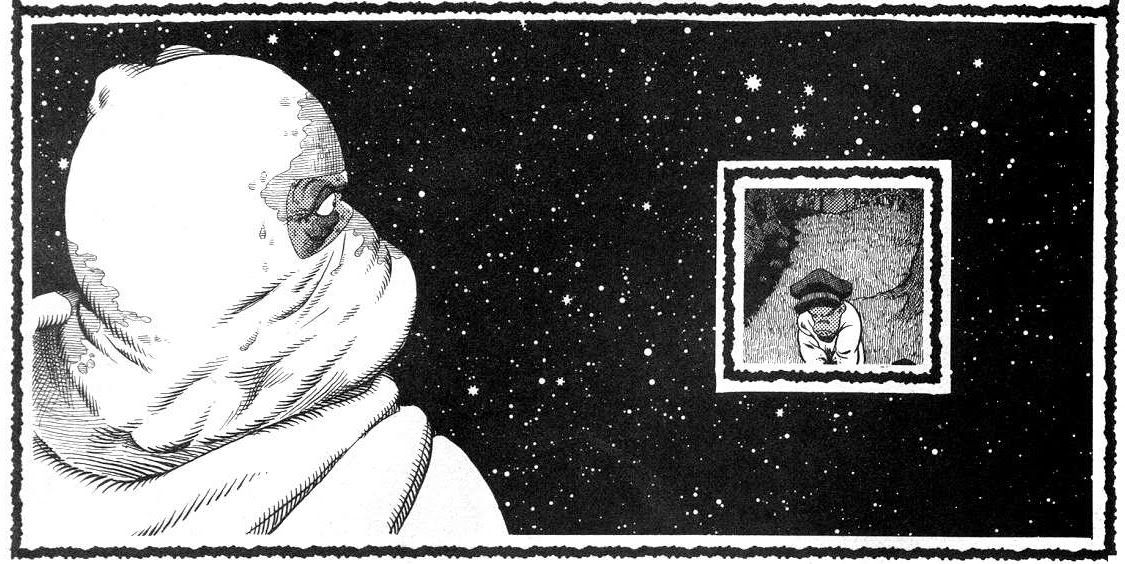
 This volume has been referred to by Dave as the conclusion of Cerebus’ story, the moment in which it all comes to a head: the Ascension, revelations about where Cerebus’ life could have gone, and also the revelation of his own creator. Dave refers to the final 100 issues as the epilogue of Cerebus’ life, reasoning that since he’s actively trying to tell somebody’s life story, he has to take into account that real people also often have a similar structure to their lives. Many people have a part of their lives that is full of possibilities, and by either happenstance or decision-making (usually a bit of both), life eventually leads to a point in which possibilities for any kind of greatness become either impossibilities, or at least improbabilities. Cerebus is pretty young to hit this point already (mid -late 30s, I believe), but then again, his life has been pretty packed until now. Also, you can’t underplay the mental trauma that Cerebus has gone through in this last volume. He’s basically been told that his life’s ambitions are objectively unreachable, and then left on a frozen dwarf planet to mull it over (and go insane in the process, something that he will carry along with him). I suppose he could be forgiven for losing some motivation.
This volume has been referred to by Dave as the conclusion of Cerebus’ story, the moment in which it all comes to a head: the Ascension, revelations about where Cerebus’ life could have gone, and also the revelation of his own creator. Dave refers to the final 100 issues as the epilogue of Cerebus’ life, reasoning that since he’s actively trying to tell somebody’s life story, he has to take into account that real people also often have a similar structure to their lives. Many people have a part of their lives that is full of possibilities, and by either happenstance or decision-making (usually a bit of both), life eventually leads to a point in which possibilities for any kind of greatness become either impossibilities, or at least improbabilities. Cerebus is pretty young to hit this point already (mid -late 30s, I believe), but then again, his life has been pretty packed until now. Also, you can’t underplay the mental trauma that Cerebus has gone through in this last volume. He’s basically been told that his life’s ambitions are objectively unreachable, and then left on a frozen dwarf planet to mull it over (and go insane in the process, something that he will carry along with him). I suppose he could be forgiven for losing some motivation.
The revelations themselves are mostly pretty funny, except for the Jaka stuff. I don’t want to give any of it away, but I will say that if you’ve gotten attached to certain characters, you’ll be getting a bit of a kick in the pants here. As this is technically the conclusion of Cerebus’ adventures, the remaining 100 don’t feature very many characters that have historically made his life particularly adventurous. That doesn’t mean, however, that the humor is also being dismissed.
 The art in this volume is certainly worthy of wrapping up the Cerebus story. Gerhard’s cosmological scenes are some of the best backgrounds ever seen in comics, or even illustration in general. The covers produce some of the very few times that I’ve wished that the comic was in color. The cover of issue #199 reveals that the surface ice of Pluto is a very pleasingly reflective red, which would look really cool in the interior, especially the scene in which Cerebus suddenly sits and sends shards of ice flying. Jupiter also gets a brilliant look in at #191—a piece I would kill to have framed on my wall. Dave and Ger do a fantastic job of looking Cerebus look absolutely tiny in a few pages in which he’s on “Juno”—and of course, he is. Dave, shines in this volume, with Cerebus’ body language and facial expressions. There’s so much kinetic energy in these pages. I’m sure it takes a lot to make issue after issue interesting with nothing but an aardvark flying through space alone, basically talking to himself, but it’s very well done. Cerebus’ looks of utter confusion, anger, defeat, hope, and more are all expertly rendered and believable that it makes the revelations that much weightier. Since the reader isn’t Cerebus, they’re basically forced by Dave to have some empathy for the little guy, no matter what their general opinion of him and hopes for his future are.
The art in this volume is certainly worthy of wrapping up the Cerebus story. Gerhard’s cosmological scenes are some of the best backgrounds ever seen in comics, or even illustration in general. The covers produce some of the very few times that I’ve wished that the comic was in color. The cover of issue #199 reveals that the surface ice of Pluto is a very pleasingly reflective red, which would look really cool in the interior, especially the scene in which Cerebus suddenly sits and sends shards of ice flying. Jupiter also gets a brilliant look in at #191—a piece I would kill to have framed on my wall. Dave and Ger do a fantastic job of looking Cerebus look absolutely tiny in a few pages in which he’s on “Juno”—and of course, he is. Dave, shines in this volume, with Cerebus’ body language and facial expressions. There’s so much kinetic energy in these pages. I’m sure it takes a lot to make issue after issue interesting with nothing but an aardvark flying through space alone, basically talking to himself, but it’s very well done. Cerebus’ looks of utter confusion, anger, defeat, hope, and more are all expertly rendered and believable that it makes the revelations that much weightier. Since the reader isn’t Cerebus, they’re basically forced by Dave to have some empathy for the little guy, no matter what their general opinion of him and hopes for his future are.
I read this one over and over again when I got it. It’s so funny and dramatic, and well “acted,” that it’s perhaps the most addictive volume of the whole series. As a kid, I also thought it was so cool to reveal to a somebody that they’re a comic book character. The only time I had ever heard of that was in Byrne’s She-Hulk, but that didn’t have quite the weight that this does. Now, if you feel it, you can stop here. If you want more, you can move on to Guys, where the alcohol is free…and there’s no last call.
Top Moments
“A sign!”
Cerebus: “Cerebus is a terrible person.”
Dave: “Well, yes, but you SAY it the same way you’d say ‘Cerebus is three feet tall.'”
“C’mon man. Haven’t you had enough yet?”
Receptionist: “Aardvark-Vanaheim”
Cerebus: “HELLO IS THIS THE PLACE THAT DOES CEREBUS?”
Receptionist: “Yes it is.”
Cerebus: “THIS IS CEREBUS CALLING. CEREBUS WOULD LIKE TO SPEAK TO DAVE’S BOSS PLEASE.”
“No more getting a little bit warm and then snowing all over himself for Cerebus…NOsir. Cerebus is going to be warm all the time. See that little gray guy over there (people will say)? He’s very, very warm. Everyone is going to be Cerebus’ friend. EVERYONE.”
Cerebus re-read 2015–2017: Reads
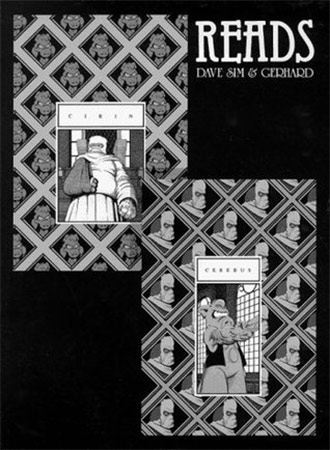 Well, here we are. I actually read this 8 months ago, but I got involved in helping out Dave and Sandeep with the Cerebus in Hell? project (view details at amomentofcerebus.com, or pick them at your local shop). Dave contends that this is the most controversial graphic novel of all time, and I have to say that if it’s not #1, it’s gotta be in the top 10. One point of controversy is that the book is split down the middle between the continuation of the events in the comic, and large chunks of straight text, which was a bit much for monthly readers at the time. You might remember the concept of “reads” themselves from Church & State. In that storyline, Weisshaupt was able to “convince” Cerebus to stay married to Sophia after an all-night bender, reassume the title of Prime Minister, and have these schlocky paperbacks ghostwritten for him. Dave takes advantage of the “reads” concept by using it in the comic as a bit of a platform for his opinions on comic publishing and on women and relationships. That second topic is what most people think of with regards to the polarized opinions surrounding this book. I’ll get to that in a bit.
Well, here we are. I actually read this 8 months ago, but I got involved in helping out Dave and Sandeep with the Cerebus in Hell? project (view details at amomentofcerebus.com, or pick them at your local shop). Dave contends that this is the most controversial graphic novel of all time, and I have to say that if it’s not #1, it’s gotta be in the top 10. One point of controversy is that the book is split down the middle between the continuation of the events in the comic, and large chunks of straight text, which was a bit much for monthly readers at the time. You might remember the concept of “reads” themselves from Church & State. In that storyline, Weisshaupt was able to “convince” Cerebus to stay married to Sophia after an all-night bender, reassume the title of Prime Minister, and have these schlocky paperbacks ghostwritten for him. Dave takes advantage of the “reads” concept by using it in the comic as a bit of a platform for his opinions on comic publishing and on women and relationships. That second topic is what most people think of with regards to the polarized opinions surrounding this book. I’ll get to that in a bit.
At the end of Women, Suenteus Po had met Astoria and Cerebus at the steps to the western church. The story picks back up here, as the three walk in together to meet with Cirin and her bodyguards. Po notes that the bodyguards are both unnecessary and useless, as Cerebus could cut them all down easily. Po asks Cirin to dismiss them, to which she agrees, seeing Po’s point that she would “lose [her] throne through force, but may yet keep it through reason. Po then addresses each of the assembled one by one, revealing certain truths in an effort to sway them from their ambitions for power. In Astoria’s case, he merely notes that as she never wanted followers or a throne, her interest in the Ascension is self-defeating since it would result in precisely those trappings. To Cirin, he reveals that Astoria had never had an abortion, and as this was the main reason for her persecuting Astoria, there is now no longer any need. He puts it to Cirin that she knew this, and that her true reason for opposing Astoria was simply that Astoria didn’t pledge undying loyalty to Cirin. He states that Cirin’s only enemy has ever been herself, and that far too much blood has been shed in hiding that truth from herself. He advises her to relinquish her power and spend the rest of her days caring for her children, the very thing that Cirinism supposedly prizes above all. When speaking to Cerebus, Po discusses the mystical nature of aardvarks and relates certain powers or strange biological events that have happened to all three of them in the past. He also discusses the aardvarks’ “magnifier” nature that we’ve seen affect people and things around Cerebus, and relates it back to his theme that the only thing people can control is themselves. He asks Cerebus if any of the times he’s been in control (as the leader of an army, as Prime Minister, or Pope) has brought him a shred of happiness. He knows the answer, of course. Po urges Cerebus to follow in his example and seek a sort of transcendent state through an ascetic lifestyle, which he mentions Cerebus had briefly touched while catatonic on the front porch of Dino’s Cafe in Melmoth.
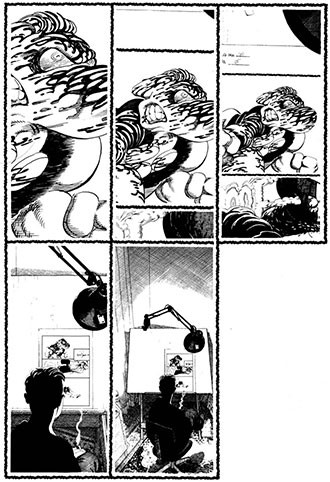 Having said his piece, Po takes his leave. Astoria, clearly convinced by Po, is the next to go, but not before revealing that Cerebus is a hermaphrodite, perhaps one of the most shocking moments of the comic thus far. She does so in order to inform Cirin that Cerebus cannot impregnate himself in order to create a line of aardvarks, which Cirin has attempted but never succeeded at. As she turns to leave, Cerebus asks her with some obvious concern where she will go, which is really rather interesting. Perhaps he feels guilty for raping her, or he appreciates her helping him in High Society. Perhaps he was touched by Po’s words and is momentarily showing some empathy for once. In any case, she leaves and after some short dialogue involving whether or not Cirin has a likeness of Cerebus growing in her armpit (one of the strange biological phenomena that Po referenced earlier), the two begin a brutal fight. Cirin proves herself to be the only opponent that we’ve seen hold their own with Cerebus, even while her arm is in a cast and Cerebus wields his sword! The battle is incredibly bloody, superbly choreographed and paced, realistic, and particularly thrilling. The fight is mostly going Cerebus’ way, until Cirin is able to wrest his sword from him and cuts off his right ear. At this point, there’s a page which depicts Dave at his desk, drawing the previous page. Suddenly back in the story, there’s a huge BANG (“something fell”) and the floor of the throne room crumbles away. The implication here is that Dave made this happen, rather than any sorcerous or religious machination in the story. Cerebus and Cirin scramble to the throne at the top of some stairs just as it detaches from the earth and ascends upward, apparently toward the moon. Cirin scans Cerebus’ mind and sees his memory of The Judge, but the throne flies completely past the moon and into space, creating some understandable anxiety in the two.
Having said his piece, Po takes his leave. Astoria, clearly convinced by Po, is the next to go, but not before revealing that Cerebus is a hermaphrodite, perhaps one of the most shocking moments of the comic thus far. She does so in order to inform Cirin that Cerebus cannot impregnate himself in order to create a line of aardvarks, which Cirin has attempted but never succeeded at. As she turns to leave, Cerebus asks her with some obvious concern where she will go, which is really rather interesting. Perhaps he feels guilty for raping her, or he appreciates her helping him in High Society. Perhaps he was touched by Po’s words and is momentarily showing some empathy for once. In any case, she leaves and after some short dialogue involving whether or not Cirin has a likeness of Cerebus growing in her armpit (one of the strange biological phenomena that Po referenced earlier), the two begin a brutal fight. Cirin proves herself to be the only opponent that we’ve seen hold their own with Cerebus, even while her arm is in a cast and Cerebus wields his sword! The battle is incredibly bloody, superbly choreographed and paced, realistic, and particularly thrilling. The fight is mostly going Cerebus’ way, until Cirin is able to wrest his sword from him and cuts off his right ear. At this point, there’s a page which depicts Dave at his desk, drawing the previous page. Suddenly back in the story, there’s a huge BANG (“something fell”) and the floor of the throne room crumbles away. The implication here is that Dave made this happen, rather than any sorcerous or religious machination in the story. Cerebus and Cirin scramble to the throne at the top of some stairs just as it detaches from the earth and ascends upward, apparently toward the moon. Cirin scans Cerebus’ mind and sees his memory of The Judge, but the throne flies completely past the moon and into space, creating some understandable anxiety in the two.
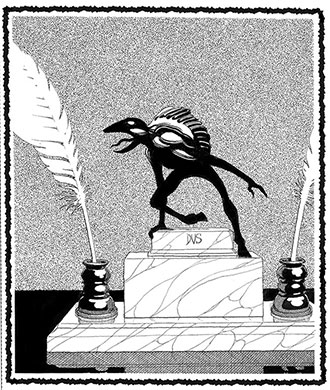 When Reads was being released monthly, half the book would be given to the story above, and the other half to pages of text on the verso with a terrific illustration on the recto. In the first half of Reads, this space is occupied by a story about a Victor Reid, who is a successful “reads” author. Reid signs a publishing deal with Vertigo Horse (get it?) to write a series called Ascension (the follow-up to his successful “Palnu Trilogy”), and his life begins to decay from there. I don’t want to get too much into the story itself—I think it would be better read and not summarized by me—but suffice it to say that Dave sees self-publishing as freedom from the prostitution to any of the major comics publishers. He also views relationships with women and domesticity as an agent for stifling creativity in men, which leads into the second half of the text portions in the book. Here, he takes on another pseudonym, Viktor Davis, and begins speaking to “the reader” directly. He speaks at length about conversations with Alan Moore and Neil Gaiman, which always made me wonder why he wrote this under a pseudonym. If he’s explicitly mentioning real people, why doesn’t he refer to himself as Dave Sim? Is it in order to convincingly speak in third person, or to separate these sections from his Note from the President? It did create some confusion at the time as to whether the opinions expressed in this section were those of this Viktor Davis character, except that Davis refers to himself as the creator of Cerebus and speaks explicitly about it (teasing the reader that Cerebus would end at issue #200 rather than #300 as previously stated). Again, this is something that is better read than summarized by a ho-hum writer like me. I’d like to be brief, as this section is fairly complicated, though I have very little confidence in whether I can do that without glossing over important details or misrepresenting them. If you’d like to know more, I’m much better at talking about this volume than in writing about it. Come see me.
When Reads was being released monthly, half the book would be given to the story above, and the other half to pages of text on the verso with a terrific illustration on the recto. In the first half of Reads, this space is occupied by a story about a Victor Reid, who is a successful “reads” author. Reid signs a publishing deal with Vertigo Horse (get it?) to write a series called Ascension (the follow-up to his successful “Palnu Trilogy”), and his life begins to decay from there. I don’t want to get too much into the story itself—I think it would be better read and not summarized by me—but suffice it to say that Dave sees self-publishing as freedom from the prostitution to any of the major comics publishers. He also views relationships with women and domesticity as an agent for stifling creativity in men, which leads into the second half of the text portions in the book. Here, he takes on another pseudonym, Viktor Davis, and begins speaking to “the reader” directly. He speaks at length about conversations with Alan Moore and Neil Gaiman, which always made me wonder why he wrote this under a pseudonym. If he’s explicitly mentioning real people, why doesn’t he refer to himself as Dave Sim? Is it in order to convincingly speak in third person, or to separate these sections from his Note from the President? It did create some confusion at the time as to whether the opinions expressed in this section were those of this Viktor Davis character, except that Davis refers to himself as the creator of Cerebus and speaks explicitly about it (teasing the reader that Cerebus would end at issue #200 rather than #300 as previously stated). Again, this is something that is better read than summarized by a ho-hum writer like me. I’d like to be brief, as this section is fairly complicated, though I have very little confidence in whether I can do that without glossing over important details or misrepresenting them. If you’d like to know more, I’m much better at talking about this volume than in writing about it. Come see me.
In a nutshell, Davis brings the reader into the book and begins manipulating the reader’s perception through the written word, which foreshadows the events in the following volume, Minds. He writes at length on reality and truth, referencing conversations on the subject with Moore and Gaiman. Gaiman once remarked that if you don’t believe in a truth, all you can say about it is that it’s at least true to somebody else. Davis relates being diagnosed as a borderline schizophrenic in 1979 and goes on to question what makes anyone’s reality objectively real. Davis then returns to his light and void cosmology/gender assessment, first seen in Church & State. He’s updated the Judge’s gender assignation, so now we have the male light and female void. The male light enjoys being with the void for a time, but eventually the void wants to be closer, ever closer. The void wants merged permanence (essentially, marriage), which leads to reiterating Davis’ position that women are an anti-muse, extinguishing the creative male light with their desire for attention. There’s some more practical discussion of human relationships based on Davis’ experience—how he witnesses women react with emotion rather than matching logical statements with likewise rebuttals. He says this creates a position from which women can never lose, as there’s no beating emotion in an argument. One simply finds oneself going in rhetorical circles.
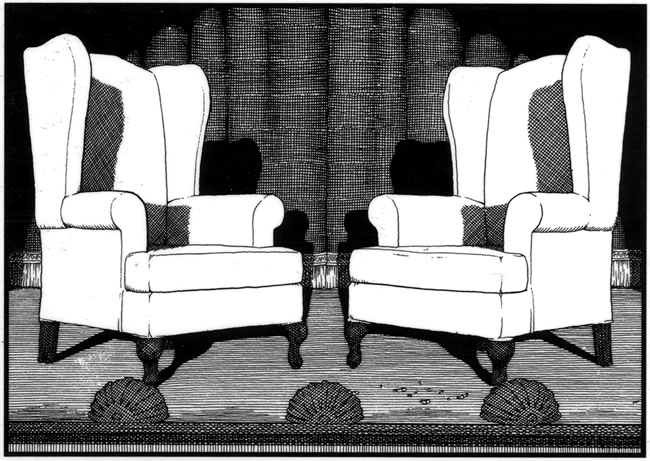
As you might imagine, this stuff created quite a stir at the time, the ripples of which are still being felt today. A lot of the Cerebus readership dropped off at this point, both because of the text blocks and what was communicated by them. Dave continues with these lines of thought today, writing most recently (in the notes for Cerebus Archive Vol. 6) about how the “feminist theology” we live under makes it impossible for males to truly be men any longer. They’ve become feminized pets in a world where any statement or belief that doesn’t belong in the feminist theology leads to the ostracizing from society of the male who uttered it (his assessment of what happened to him after this volume). Effectively neutered, men are at the mercy of a society which Dave sees as different from the Cirinist takeover of Iest only by a matter of degree.
Now, Dave writes at length about how the public thinks of him as “crazy Dave Sim, the misogynist.” Whereas he would consider himself to simply have more clarity than most, and certainly a more conservative or traditional philosophy of gender roles. I do know that he believes himself to be objectively correct in his beliefs. It’s also clear that he is disappointed by what he perceives to be the comics world’s view of him; Margaret Liss has started a petition on his behalf (available here) that states that the signer does not believe that Dave is a misogynist. Until that petition reaches 2,000 signatures, Dave won’t consider appearing in public. It’s hard to say whether he particularly laments his position in that community, though—he does talk about it a lot, and as a comics fan, I suppose he may at least miss talking with more people in the field about the field. But he also claims to be fully content to live a fairly ascetic lifestyle as dictated by his religion, so perhaps he would accept his position even if his views were not vilified. Up until Reads (his essay, “Tangent,” which was explicitly written by Dave Sim rather than under a pseudonym, hadn’t been published yet) readers could wave away some of the less palatable ideas throughout the series by saying they’re just part of the story—opinions of the characters, not the author. In this volume, however, Dave broke down the wall between reader and author and opened himself up to direct criticism of his views, pseudonym notwithstanding.
The revelation of these views was somewhat unexpected by many. Dave created what could be interpreted as compelling, strong female characters (Astoria, Jaka, etc.), but now he would say that this would be misinterpreting them, or perhaps that those qualities we enjoy about those characters are not actually admirable. I can’t speculate on the catalyst for Dave’s opinions. Some people cite his divorce from Deni as a source, some people cite his borderline schizophrenia diagnosis. I find the divorce hypothesis to be thin because Dave considers that to have been a marriage of mutual ambition more than any sort of passionate love, so I doubt he felt particularly raw about it. The schizophrenia would have to be damn borderline indeed, because by most accounts Dave very generally doesn’t seem to have any problem with perceiving reality, either in person, on video, or in writing. I’d be very interested to have spoken to him on the subject during his High Society or Church & State days to see whether his views were markedly different or if he just mostly kept them to himself. To me, Dave’s writing on the subject (aside from the cosmology stuff) comes off a lot more just like an eloquent MRA, and those are people that I don’t think (generally, of course) have a clinical imbalance. I’m not a sociologist or a psychologist, so I’ll decline to comment on that further, but those two arguments just don’t ring true to me.
Something that a lot of people can’t or don’t want to do is separate the art from the artist, especially if that artist has views that are antithetical to their own. I often separate art from artists to fairly high degree—to be perfectly frank, most artists have questionable views or have acted problematically, and I’d prefer to not have my enjoyment of any art colored by the views or behavior of its creator. That would be a truly irrational thing, because Cerebus means the world to me and I don’t see any point of having tiny fractions of it that I don’t agree with poison the entire thing. There are parts of it that I don’t fully agree with (though I have signed the petition), but I do understand where he’s coming from on certain points, and I have experienced some of his observations firsthand. Generalization is dangerous of course, but I’ve been in a number of relationships and I think his assessment of how men and women relate to one another is humorously accurate in my experience. In any case, what Dave thinks and what I think and what other people think is immaterial to my enjoyment of this work. The controversial sections of Reads are a pretty small fraction of the full 300, and even if I don’t agree with all of it, at least it’s written well.
Ok—back to the comic, now that I’ve thoroughly bungled my write-up of this volume. I’m not positive that I’ve correctly stated my position on any of this, but I’ve been sitting on it for months and want to move on. Next: Minds.
Cerebus re-read 2015–2016: Women
 Welcome back to Mothers & Daughters! On today’s episode, Dave finally makes good on a part of the story on which he’s been slowly shedding light since about 1979. Most readers probably thought to themselves many a time over the years, “what the hell is a ‘Cirinist,’ and somewhat fewer times, “what the hell is a ‘Kevillist’.” You have to hand it to Dave, he was never particularly entranced by the concept of world-building—a valuable tool in the writer’s arsenal, to be sure, but absolutely one that gets overused by sci-fi and fantasy writers to cover the fact that they don’t have much of a plot. Dave’s priority was telling a story, first and foremost, with the more obscure points of Estarcion’s politics being reserved for a wonderful little payoff called Women.
Welcome back to Mothers & Daughters! On today’s episode, Dave finally makes good on a part of the story on which he’s been slowly shedding light since about 1979. Most readers probably thought to themselves many a time over the years, “what the hell is a ‘Cirinist,’ and somewhat fewer times, “what the hell is a ‘Kevillist’.” You have to hand it to Dave, he was never particularly entranced by the concept of world-building—a valuable tool in the writer’s arsenal, to be sure, but absolutely one that gets overused by sci-fi and fantasy writers to cover the fact that they don’t have much of a plot. Dave’s priority was telling a story, first and foremost, with the more obscure points of Estarcion’s politics being reserved for a wonderful little payoff called Women.
The book primarily consists of a quick 1-2-3-4 rotating punch of alternating events, setting up its separate plotlines. Punisherroach, having naively just fallen in love with a prostitute named Blossom, comes to the realization that she is not the new, pure flower her name implies, and sinks into the darkest of depressions. He sheds his vengeful persona and becomes “Swoon,” a pitch-perfect (though somewhat self-love obsessed) send up of Neil Gaiman’s Sandman. Dressing Elrod in women’s clothes and a black wig, he reveals that Elrod is now his sister, “Snuff (Death),” and informs him that a great battle is imminent. Across town, Astoria is occupied with preparing for her meeting with Cirin, her exacting standards coming to the fore in very humorous and cutting remarks to her hairdresser and a clothing retailer. Cirin, meanwhile, receives up-to-the-minute information that her files on Astoria and Kevillism have been replaced by forces unknown with a much funnier series of documents. Cerebus re-enters the physical world above a house in lower Iest, the skylight of which he promptly crashes through. He’s warmly received by an unnamed woman in her late middle age, who has been assigned a Cirinist “custodian.” This custodian, the woman asserts, is between a rock and a hard place, as her first order is to write down everything that the woman says, but she also knows how much Cirin is going to want to know that Cerebus has returned. Does the custodian leave to alert Cirin, thereby missing whatever the unnamed woman has to say, or does she write down everything and risk punishment for not passing along this extremely important turn of events? Cerebus’ host offers him a scotch and proceeds to uncover what was seen by the reader in the last volume, Flight: “All women read minds, with very few exceptions.” She proceeds to elaborate very poetically on this point, and though it can be viewed by some as perhaps one of the first explicit examples of Dave’s polarizing opinions, it is some of his most skillful and beautiful writing yet. The woman also vaguely mentions that she had a fairly large part to play in the rise of Cirinism, which she now views as an abomination. In the midst of this explanation, she apparently says too much, as her custodian storms off to report Cerebus’ return. The woman gives Cerebus some money and ushers him to a side door which she explain will lead him through a secret passageway to a tavern in town.
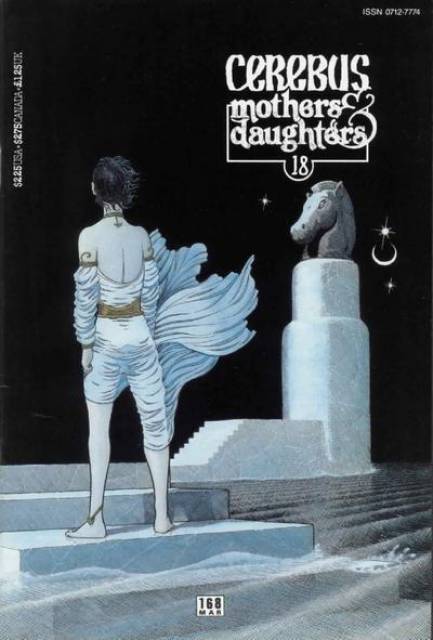 There is a conversation among Cirin and her generals regarding the reappearance of Cerebus displayed as a script next to a brilliant Gerhard illustration of the window of Cirin’s room at the Regency. The usual scapegoats of the Illusionists or Lord Julius are suggested. However, though they know where Cerebus is holed up, they aren’t able to do anything about it. Cirin’s Alcohol Sanction prohibits women from entering taverns. So they watch from afar as Cerebus begins sleepwalking up to the roof, where he raises his sword arm, causing a great spire to grow from the ridge of the Black Tower which encircles Upper Iest. As he belches, it breaks off and falls on the Regency, causing chaos and conflicting reports that Cirin is either dead, injured or perfectly fine. Astoria, en route to the Regency with a Cirinist guard, is caught in the crossfire of this chaos, with many Cirinists trying to kill her on the spot, based on what they think are Cirin’s orders. She falls from the cab and breaks her arm before she is whisked into an alley by her guard. She passes out promptly. Cerebus returns to the tavern downstairs, where he is informed by Dirty Fleagle of what has occurred, at which point Cerebus orders his first (as seen by us, anyway) bucket of scotch (side note: Estarcion is a fictional continent that does not include Scotland. How in the world do they have scotch?).
There is a conversation among Cirin and her generals regarding the reappearance of Cerebus displayed as a script next to a brilliant Gerhard illustration of the window of Cirin’s room at the Regency. The usual scapegoats of the Illusionists or Lord Julius are suggested. However, though they know where Cerebus is holed up, they aren’t able to do anything about it. Cirin’s Alcohol Sanction prohibits women from entering taverns. So they watch from afar as Cerebus begins sleepwalking up to the roof, where he raises his sword arm, causing a great spire to grow from the ridge of the Black Tower which encircles Upper Iest. As he belches, it breaks off and falls on the Regency, causing chaos and conflicting reports that Cirin is either dead, injured or perfectly fine. Astoria, en route to the Regency with a Cirinist guard, is caught in the crossfire of this chaos, with many Cirinists trying to kill her on the spot, based on what they think are Cirin’s orders. She falls from the cab and breaks her arm before she is whisked into an alley by her guard. She passes out promptly. Cerebus returns to the tavern downstairs, where he is informed by Dirty Fleagle of what has occurred, at which point Cerebus orders his first (as seen by us, anyway) bucket of scotch (side note: Estarcion is a fictional continent that does not include Scotland. How in the world do they have scotch?).
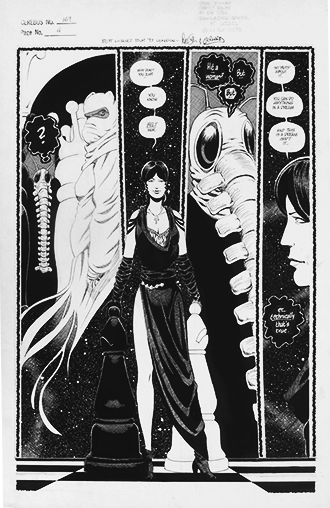 I had read in another review that this book could have just as easily been titled “Dreams.” Backing up that assertion, what follows is a series of dreams, as Cerebus dreams of sitting on the roof of the Regency with the Elf, as she explains to him how she is technically his daughter, as he created her from his subconscious as a result of his visit to the Eighth Sphere. Astoria, recovering in a small hotel protected by a cadre of Kevillists and Cirinist defectors, dreams of her father, who turns out to be Swoon (dream logic), who has found a way to mimic Morpheus’ dream-hopping abilities, as he also makes his way into the dreams of Cirin, similarly recovering from a broken arm and minor fever while in an unexplainable coma. The tables are turned though, when Cirin finds out about Swoon’s “hobby,” and chases him from dream to dream, haranguing him about his filthy habits. Eventually Astoria shows up in Cirin’s dream as Swoon departs and at Cirin’s goading, delivers a terrific right cross the the old battle axe’s snout. Meanwhile, a very tall, cloaked and hooded character is seen walking the streets of Iest. Cirin eventually wakes from her coma, and after some to-do with her generals, telepathically sends a blanket statement to the entire city from the Western Church, the power of which provides splitting headaches for all the men. She calls upon Astoria and her followers to surrender their hotel stronghold and promises no harm. Astoria prepares for a siege as Cirin’s troops surround the hotel, but suddenly has a vision which compels her to leave the hotel unprotected and unarmed. at the same moment, Cerebus experiences an an aural cue to also leave the safety of the tavern. He leaves through the second story window and leaps among the rooftops while Astoria calmly walks down the road toward the western church. Cerebus slips and realizes he can now fly, as he barrels toward the upper city. Cirin’s troops telepathically ask Cirin for a judgment on Astoria. In the absence of any actual crime being committed, Cirin opts for that old chestnut, sorcery, and orders execution. At the last moment, Astoria whispers “go away,” as Cerebus did to her in Church & State, with identical results. Many women on the sidelines bow to Astoria at this turn of events. There is a state of panic among the troops in the immediate vicinity of Cirin, which is quelled by a report that Cirin’s golden sphere has collapsed on one side, making her Ascension impossible. She defends herself against two treasonous would-be assassins, then proceeds to the papal audience chamber with her remaining faithful to receive Astoria. Astoria arrives at the church as Cerebus makes an adorable crash-landing. As he raises his sword to kill Astoria, the cloaked figure arrives and reveals himself to be Suenteus Po. He ushers the two into the church, not wanting to keep their hostess waiting.
I had read in another review that this book could have just as easily been titled “Dreams.” Backing up that assertion, what follows is a series of dreams, as Cerebus dreams of sitting on the roof of the Regency with the Elf, as she explains to him how she is technically his daughter, as he created her from his subconscious as a result of his visit to the Eighth Sphere. Astoria, recovering in a small hotel protected by a cadre of Kevillists and Cirinist defectors, dreams of her father, who turns out to be Swoon (dream logic), who has found a way to mimic Morpheus’ dream-hopping abilities, as he also makes his way into the dreams of Cirin, similarly recovering from a broken arm and minor fever while in an unexplainable coma. The tables are turned though, when Cirin finds out about Swoon’s “hobby,” and chases him from dream to dream, haranguing him about his filthy habits. Eventually Astoria shows up in Cirin’s dream as Swoon departs and at Cirin’s goading, delivers a terrific right cross the the old battle axe’s snout. Meanwhile, a very tall, cloaked and hooded character is seen walking the streets of Iest. Cirin eventually wakes from her coma, and after some to-do with her generals, telepathically sends a blanket statement to the entire city from the Western Church, the power of which provides splitting headaches for all the men. She calls upon Astoria and her followers to surrender their hotel stronghold and promises no harm. Astoria prepares for a siege as Cirin’s troops surround the hotel, but suddenly has a vision which compels her to leave the hotel unprotected and unarmed. at the same moment, Cerebus experiences an an aural cue to also leave the safety of the tavern. He leaves through the second story window and leaps among the rooftops while Astoria calmly walks down the road toward the western church. Cerebus slips and realizes he can now fly, as he barrels toward the upper city. Cirin’s troops telepathically ask Cirin for a judgment on Astoria. In the absence of any actual crime being committed, Cirin opts for that old chestnut, sorcery, and orders execution. At the last moment, Astoria whispers “go away,” as Cerebus did to her in Church & State, with identical results. Many women on the sidelines bow to Astoria at this turn of events. There is a state of panic among the troops in the immediate vicinity of Cirin, which is quelled by a report that Cirin’s golden sphere has collapsed on one side, making her Ascension impossible. She defends herself against two treasonous would-be assassins, then proceeds to the papal audience chamber with her remaining faithful to receive Astoria. Astoria arrives at the church as Cerebus makes an adorable crash-landing. As he raises his sword to kill Astoria, the cloaked figure arrives and reveals himself to be Suenteus Po. He ushers the two into the church, not wanting to keep their hostess waiting.
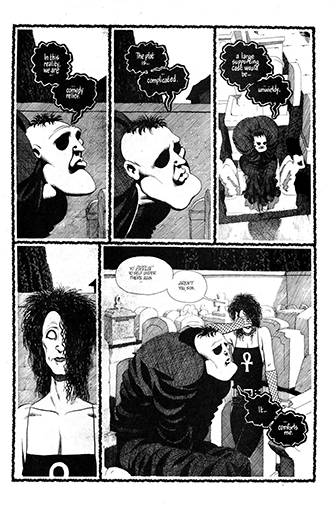 To me, this volume always seemed to be just the second part of Flight. It’s not quite different enough from that volume as it is from the next two volumes, and it ends with a much better cliffhanger than Flight does. I’ve often wondered why Dave split Mothers & Daughters up into four separate books, when it would really make a rather nice two volume set like Church & State. That being said, Women is certainly one of the most tense volumes in the entire series so far. That’s saying a lot, considering how much of it is taken up with dreams, but the pacing of the scene cuts and the import of each character’s arc really sets the tension perfectly. It’s not uncommon to read this volume very much on the edge of your seat. The name of the volume is a bit of a strange thing, however. The story is really just about Cirin and Astoria, and with any other women being side characters. Cerebus spends most of the time being drunk and performing magic unknowingly, and the Roach spends most of the time jerking it.
To me, this volume always seemed to be just the second part of Flight. It’s not quite different enough from that volume as it is from the next two volumes, and it ends with a much better cliffhanger than Flight does. I’ve often wondered why Dave split Mothers & Daughters up into four separate books, when it would really make a rather nice two volume set like Church & State. That being said, Women is certainly one of the most tense volumes in the entire series so far. That’s saying a lot, considering how much of it is taken up with dreams, but the pacing of the scene cuts and the import of each character’s arc really sets the tension perfectly. It’s not uncommon to read this volume very much on the edge of your seat. The name of the volume is a bit of a strange thing, however. The story is really just about Cirin and Astoria, and with any other women being side characters. Cerebus spends most of the time being drunk and performing magic unknowingly, and the Roach spends most of the time jerking it.
I really like Astoria as a character. She’s smarter and stronger than almost anyone else in the series, and it’s fantastic to get a better look inside her head than we got in High Society, in which she was a simple manipulator. It’s a shame that Dave finally figured out how to draw her consistently, two volumes before he stops using her as a character. It’s also great to finally have some description of what the heck Cirinism and Kevillism are. These illuminations take the form of single page quotes from Cirin and Astoria from various written sources, laid out side by side and discussing the same topic. Astoria comes off as being quite reasonable and fairly liberal, while Cirin reads a bit like a hyper-conservative nutjob.
The text-only conversations between Cirin and her generals are beautiful reading. I’ve said this before, but Dave has such a command of natural dialogue. It’s such a rare treat to read what basically amounts to the script of a play, without really feeling particularly aware of that fact. It’s so fluid, and you can really imagine people speaking like this. These sections also provide Gerhard with a really nice opportunity to draw some lovely architecture without having to make room for any characters. These pages are understated, but some of my favorite moments in all of Cerebus.
So, now it’s time for a cliffhanger of my own. Women is the volume that a lot of readers make their last, because of what comes next. There’s hints of what’s upcoming in this volume, but my next entry will be a review of
The! Most! Controversial! Graphic! Novel! Of! All! Time!
Top Moments
“Buggid”
“ELF! WHAT A THING TO SAY!”
Our last exposure to Lord Julius. Dave gives him a great send off. Nothing epic or obviously final, but just terrific writing.
Cerebus (drunk): “Cerbus allus LIKED you. Dudyou KNOW thad?”
Dirty Drew: “uh-huh. Yuh jest TOLD me.”
pp. 232–233 have some really inspired paneling, adding to the aforementioned tension
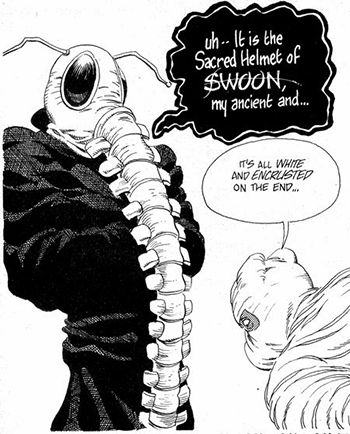
Cerebus re-read 2015–2016: Flight
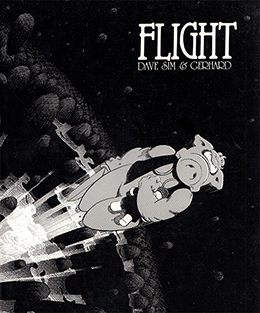 Boy, I’m not even sure where to begin with this one. It’s so dense, considering how short it is—I’ll try to keep the synopsis from spiraling out of control. I suppose the appropriate beginning point is to mention that this is the first volume in a four-part storyline called Mothers & Daughters, which Dave and Ger had been building up to very slowly since the first volume. Up until this point, the Cirinists have been mostly heard about and rarely seen, and these volumes go a long way into shedding some light on their inner workings and those of their rivals, the Kevillists (even less is known of them until now). Mothers & Daughters itself caps off the second third of Cerebus, and is very climactic in places, so we’re in for a wild ride.
Boy, I’m not even sure where to begin with this one. It’s so dense, considering how short it is—I’ll try to keep the synopsis from spiraling out of control. I suppose the appropriate beginning point is to mention that this is the first volume in a four-part storyline called Mothers & Daughters, which Dave and Ger had been building up to very slowly since the first volume. Up until this point, the Cirinists have been mostly heard about and rarely seen, and these volumes go a long way into shedding some light on their inner workings and those of their rivals, the Kevillists (even less is known of them until now). Mothers & Daughters itself caps off the second third of Cerebus, and is very climactic in places, so we’re in for a wild ride.
After slaughtering a couple Cirinists in a vengeful rage at the end of Melmoth, Cerebus books it into the heart of Iest’s lower city as he runs for his life. As a result of Cirinist’s ability to speak to one another telepathically, Cerebus is also fighting for his life, as droves of Cirinists descend upon him. Cirin (who we learned in Church & State is one of an indeterminate number of aardvarks in Estarcion) is telepathically alerted to these events by one of her generals, as she is busy purging the papal library of undesirable books and searching for any that may give her an advantage in taking part in her own Ascension. Cirin—believing Cerebus to be dead since he Ascended—is at first incredulous, but is at least partly convinced of his return by mental images of a dozen or so of her dead soldiers. As some Iestans witness the bloodshed from their homes and begin cheering on their former pope, Cerebus spots an opportunity. He climbs the side of a house and commands all Iestans to take back their city from the Cirinists by force. This is a stirring speech, and very effective, until the action begins. The Cirinists are a highly trained force and make very short work of the locals. Disobeying Cirin’s orders to take Cerebus alive (we’ll find out her motive in two more volumes), General Normina Swartzkof orders her archer to shoot Cerebus through the heart. At the last second, he disappears into thin air, the arrow flying through the window behind him. Cirin believes this to be the work of Suenteus Po, and orders any witnesses (barring mothers and children under five) to be executed in an effort to quell any further revolution.
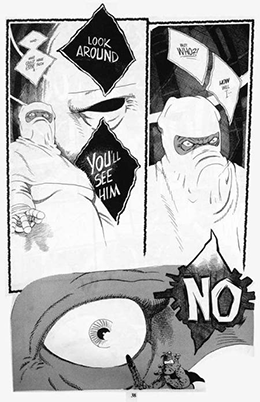 Meanwhile, the Roach, having lain dormant as “Normalroach” for the entirety of Melmoth, begins to feel that monumental changes are afoot. Estarcion itself feels these changes as well, as a number of characters from the first volume are returned to, and in most cases blinked out of existence as a result of Cerebus’ partial victory. This is the most explicit and powerful depiction of Cerebus’ “magnifier effect.” His unconscious ability to affect the world around him will be a major focus of Mothers & Daughters. The Roach changes himself into Punisherroach in order to align himself with Cerebus in a bid to defeat the Cirinists. He does this quite efficiently with his semi-automatic crossbows, and racks up a much higher body count than Cerebus did before he vanished. We find that Cerebus has returned to the Seventh Sphere, a sort of metaphysical environment that is shaped by one’s individual imagination, and a frequent hangout of Suenteus Po, noted Illusionist. Cerebus begins to fly upward, stating that he wants to see how far up it goes, for no other reason than curiosity and stubbornness. Though Po is particularly against this idea, Cerebus eventually breaks out of the Seventh Sphere and into the Eighth, which is pitch black in all directions, though “directions” is perhaps the wrong word, as Po tells Cerebus there are none here. However, as a manifestation of Cerebus’ psyche, the plane does allow for review of any point in one’s life. Po demonstrates this by making Cerebus relive the moments in his life in which he felt pure joy. Cerebus snaps out of it and decides to head upward again, reasoning with Po that he’s fed up with everyone around him trying to distract him. He sees a platform in the distance and despite the incredible physical pressure exerted upon him, makes his way over the top. There he finds an enormous chessboard and the translucent, imposing image of Suenteus Po, the third (of three) aardvarks in Estarcion.
Meanwhile, the Roach, having lain dormant as “Normalroach” for the entirety of Melmoth, begins to feel that monumental changes are afoot. Estarcion itself feels these changes as well, as a number of characters from the first volume are returned to, and in most cases blinked out of existence as a result of Cerebus’ partial victory. This is the most explicit and powerful depiction of Cerebus’ “magnifier effect.” His unconscious ability to affect the world around him will be a major focus of Mothers & Daughters. The Roach changes himself into Punisherroach in order to align himself with Cerebus in a bid to defeat the Cirinists. He does this quite efficiently with his semi-automatic crossbows, and racks up a much higher body count than Cerebus did before he vanished. We find that Cerebus has returned to the Seventh Sphere, a sort of metaphysical environment that is shaped by one’s individual imagination, and a frequent hangout of Suenteus Po, noted Illusionist. Cerebus begins to fly upward, stating that he wants to see how far up it goes, for no other reason than curiosity and stubbornness. Though Po is particularly against this idea, Cerebus eventually breaks out of the Seventh Sphere and into the Eighth, which is pitch black in all directions, though “directions” is perhaps the wrong word, as Po tells Cerebus there are none here. However, as a manifestation of Cerebus’ psyche, the plane does allow for review of any point in one’s life. Po demonstrates this by making Cerebus relive the moments in his life in which he felt pure joy. Cerebus snaps out of it and decides to head upward again, reasoning with Po that he’s fed up with everyone around him trying to distract him. He sees a platform in the distance and despite the incredible physical pressure exerted upon him, makes his way over the top. There he finds an enormous chessboard and the translucent, imposing image of Suenteus Po, the third (of three) aardvarks in Estarcion.
Po engages Cerebus in a game of chess. For every move Po makes, he tells Cerebus a little of his own history. For every move of Cerebus’, he is transported either physically or as an apparition to the locations of individuals from his past. We see King K’cor of Imesh, mad as a hatter as a result the loss of his beloved Sedra; Archbishop Posey in prison with Oscar (the Jaka’s Story one); and the enormous vision of a decayed Bran Mac Mufin. Po also relates to Cerebus his side of the trial in which Po was burned as a heretic—it was this that Cerebus saw in his vision before his Ascension. Po checkmates Cerebus and he is cast away from the chessboard.
Back in Estarcion, it seems everything is boiling. Punisherroach is taking out Cirinists left and right, the Pigts are marching toward Iest in order to take it back by force, and Cirin’s ascension continues to be stymied by inexplicable miscommunications and rotten luck. As a result, she orders Astoria to be temporarily released from prison and brought in to council Cirin on what she knows of Cerebus and his illusions. Astoria outlines conditions for this request, arguing that if Cirin is coming to her for help, she must be on considerably shaky ground. Eventually, Elrod shows up and attempts to get Punisherroach to accompany him to a brothel in order to let off some steam, which the Roach is not game for. He allows himself to be dragged along anyway—despite his striving for purity, he cannot quell his susceptibility to temptation. He is seen to by a prostitute named Blossom, who he promptly falls very much in love with, to Elrod’s alarm. Meanwhile, the evening before Astoria and Cirin’s meeting, they both see a vision of Cerebus re-entering their plane of existence.
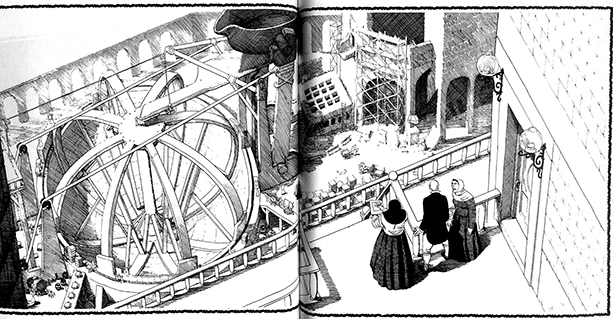
Flight is great because it’s a terrific release after a couple years of very little Cerebus, less humor, and almost no action. The book is extremely frenetic, and it’s the most edge-of-one’s-seat action not only since the first volume, but in the whole series thus far. Dave’s paneling becomes a huge asset again as he’s able to push the action forward much more dynamically and fluidly than a lot of other artists at the time. His increasingly strong partnership with Gerhard also facilitates this, as it gives the characters something solid to work against, and a lot of depth to work within. It’s a very cathartic section of the story, and I often wonder if parallels can be drawn between the enthusiasm of Cerebus’ supporters and supporters of Cerebus at the time.
Another great detail of this volume is the reappearance of many of the interesting and varied antagonists from the first volume. Interspersed throughout the battle scenes, Dave’s well-paced vignettes centered on these characters definitely evoke a sense of things wrapping up or coming full circle—a theme of the entire Mothers & Daughters storyline. It’s a lot of fun to see Dave take a crack at drawing these characters again for the first time in a little over 10 years, especially Khem (referred to as a demon here, but as a succubus in issue #2), who was previously defined simply by the negative space around it. Here, Khem is given what seems to be more of a corporeal form, as Dave draws contours and textural details on it.
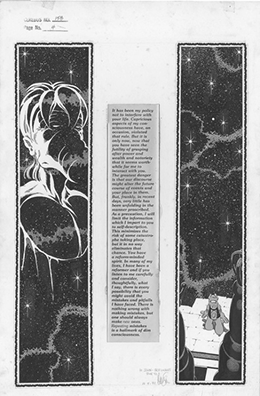 There are two aspects of Flight that I find particularly important, and which become more so over the course of this storyline. One is certain revelations about Cerebus’ past that we learn through something other than casual conversation with Countess Michele. Po is able to tell Cerebus (and us) about very specific moments of his life from before the first volume in great detail, even down to the emotion he felt at the time. This is the most we’ve ever learned about who Cerebus really is, where he comes from, and what makes him tick. We’re going to get a lot more of that coming up. Secondly, we also learn a lot more about the Cirinists, particularly their telepathic ability. Dave represents this skill/power quite uniquely as floating diamond-shaped thought bubbles—white for regular conversation and black with white text for extreme emphasis. It’s the first visual we’ve seen that illustrates Bear’s comment on the Cirinist’s hive-mind, and goes a long way into explaining how they’ve been so successful in taking over Iest. We also get a look into the inner workings of the Cirinist government, with Cirin obviously on top, and her followers filling in various positions below her—subservient, yet generally not shy about speaking their mind as long as they hold a high enough position. Cirin is clearly not a ruthless dictator to the point of instantly killing anybody with an opposing opinion, at least where mothers are concerned. However, she will not tolerate detractors for too long, as we’ll see in the next volume, Women.
There are two aspects of Flight that I find particularly important, and which become more so over the course of this storyline. One is certain revelations about Cerebus’ past that we learn through something other than casual conversation with Countess Michele. Po is able to tell Cerebus (and us) about very specific moments of his life from before the first volume in great detail, even down to the emotion he felt at the time. This is the most we’ve ever learned about who Cerebus really is, where he comes from, and what makes him tick. We’re going to get a lot more of that coming up. Secondly, we also learn a lot more about the Cirinists, particularly their telepathic ability. Dave represents this skill/power quite uniquely as floating diamond-shaped thought bubbles—white for regular conversation and black with white text for extreme emphasis. It’s the first visual we’ve seen that illustrates Bear’s comment on the Cirinist’s hive-mind, and goes a long way into explaining how they’ve been so successful in taking over Iest. We also get a look into the inner workings of the Cirinist government, with Cirin obviously on top, and her followers filling in various positions below her—subservient, yet generally not shy about speaking their mind as long as they hold a high enough position. Cirin is clearly not a ruthless dictator to the point of instantly killing anybody with an opposing opinion, at least where mothers are concerned. However, she will not tolerate detractors for too long, as we’ll see in the next volume, Women.
Top Moments
The cover of issue #151. A perfectly framed, top Gerhard moment.
Death finding out from the Judge that he’s not actually Death and that he’s moments away from ceasing to exist.
Mrs. Copps’ conversation with Hammond in which he tries to explain to her that he can’t change the specifications of Cirin’s sphere mold without dismantling it and starting from scratch. You’d think Dave had some personal experience with this kind of client.
K’cor: “What is life like on the moon?”
Cerebus: “Like Imesh.”
K’cor: “eh?”
Cerebus: Empty…gray…except for one crazy old coot called The Judge…who talks about nothing but The Goddess all the time…”
Cirin’s conversation with her messenger about Astoria. The way that Dave implies timing in conversations makes Cerebus reads more naturally than any other comic I can think of.
Lord Julius’ confrontation with a would-be assassin in his bedchamber.
Cerebus re-read 2015–2016: Melmoth
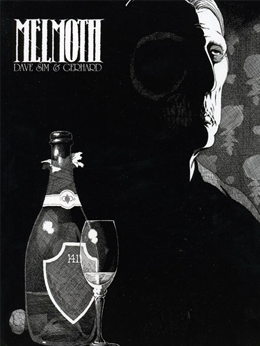 While researching Oscar Wilde for Jaka’s Story, Dave was sufficiently inspired by what he read to devote an entire storyline to the author/playwright, and in the process, befuddle fans of the book by giving Cerebus even less to do than in the previous 34 issues. As if that wasn’t enough, he confused longtime readers even further by making it clear that this wasn’t the same Oscar Wilde from Jaka’s Story. Of course, Oscar had been taken away by the Cirinists at the end of that book, so he was a bit busy at the time. Luckily for Dave, there just so happened to be another author in Estarcion with the exact same name, appearance, and ready wit. Lucky for us, too, because this is a fantastic, haunting work that never fails to grip my heart. This may be because this is the first time that Cerebus has flirted with non-fiction, as Melmoth is the story of the real Oscar Wilde’s final days.
While researching Oscar Wilde for Jaka’s Story, Dave was sufficiently inspired by what he read to devote an entire storyline to the author/playwright, and in the process, befuddle fans of the book by giving Cerebus even less to do than in the previous 34 issues. As if that wasn’t enough, he confused longtime readers even further by making it clear that this wasn’t the same Oscar Wilde from Jaka’s Story. Of course, Oscar had been taken away by the Cirinists at the end of that book, so he was a bit busy at the time. Luckily for Dave, there just so happened to be another author in Estarcion with the exact same name, appearance, and ready wit. Lucky for us, too, because this is a fantastic, haunting work that never fails to grip my heart. This may be because this is the first time that Cerebus has flirted with non-fiction, as Melmoth is the story of the real Oscar Wilde’s final days.
 The story focuses on Wilde following his release from two years’ hard labor. Dave scripts some speculative conversation at the beginning of the book, in which Wilde discusses with Robert Ross the works of his similarly-named peer (“Jaka’s Story” having been renamed “Daughter of Palnu,” likely against the author’s intentions, Oscar asserts), as well as the state of publishing in the now Cirinist-run Iest. From there, Sim hands the writing over to Ross and Reggie Turner, which takes the form of actual letters that the two friends sent back and forth as they took it in turns to care for a rapidly declining Wilde, who is staying in a hotel in lower Iest. Dave typesets the text above beautifully rendered, mostly sequential illustrations of the contents of the letters. These sequences are incredibly effective because they are handled so respectfully by Dave and Gerhard. None of it is played for laughs (except the occasional Wilde witticism), and it’s free to be as dark and disturbing as is necessary to fully depict the emotional weight that Ross and Turner must have been carrying as they watched their friend die.
The story focuses on Wilde following his release from two years’ hard labor. Dave scripts some speculative conversation at the beginning of the book, in which Wilde discusses with Robert Ross the works of his similarly-named peer (“Jaka’s Story” having been renamed “Daughter of Palnu,” likely against the author’s intentions, Oscar asserts), as well as the state of publishing in the now Cirinist-run Iest. From there, Sim hands the writing over to Ross and Reggie Turner, which takes the form of actual letters that the two friends sent back and forth as they took it in turns to care for a rapidly declining Wilde, who is staying in a hotel in lower Iest. Dave typesets the text above beautifully rendered, mostly sequential illustrations of the contents of the letters. These sequences are incredibly effective because they are handled so respectfully by Dave and Gerhard. None of it is played for laughs (except the occasional Wilde witticism), and it’s free to be as dark and disturbing as is necessary to fully depict the emotional weight that Ross and Turner must have been carrying as they watched their friend die.
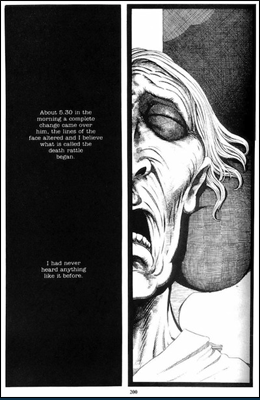 The book is able to reach this darkness because there is, in fact, some comic relief. Cerebus, believing Jaka to be dead after the Cirinist ransacking of her home and workplace, is in a near catatonic state. He still has his single gold coin, and offers it to Dino, the proprietor of a cafe/hotel next door to Oscar’s in exchange for lodging and food for the rest of his life. So in between sequences of Oscar’s decline, Cerebus sits on the porch right next door, blankly staring out into the lower city while familiar characters walk by with various degrees of acknowledgement of him. One of the funnier instances is the reappearance of Princes Mick and Keef, who were able to escape Cirinist punishment by agreeing to marry the Buttock sisters, a fate which seems to be just barely the lesser of two evils. Following Oscar’s death, two Cirinists stand in front of Dino’s Cafe, one advising the other on prisoner discipline with her story of how violently she treated Jaka while she was in custody. This snaps Cerebus out of his catatonia very quickly, and he kills both Cirinists on the spot. He then remembers Bear telling him many years ago about how Cirinists somehow have a hive-mind, and that if Bear had ever killed a Cirinist, he’d kill himself immediately rather than experience the wrath of the inevitable swarm of vengeance. Cerebus nearly follows through with this (with the Judge’s forecast of lonely end echoing in his mind), but a group of Cirinists interrupts him, having somehow felt the death of their two comrades, and Cerebus chooses to run instead.
The book is able to reach this darkness because there is, in fact, some comic relief. Cerebus, believing Jaka to be dead after the Cirinist ransacking of her home and workplace, is in a near catatonic state. He still has his single gold coin, and offers it to Dino, the proprietor of a cafe/hotel next door to Oscar’s in exchange for lodging and food for the rest of his life. So in between sequences of Oscar’s decline, Cerebus sits on the porch right next door, blankly staring out into the lower city while familiar characters walk by with various degrees of acknowledgement of him. One of the funnier instances is the reappearance of Princes Mick and Keef, who were able to escape Cirinist punishment by agreeing to marry the Buttock sisters, a fate which seems to be just barely the lesser of two evils. Following Oscar’s death, two Cirinists stand in front of Dino’s Cafe, one advising the other on prisoner discipline with her story of how violently she treated Jaka while she was in custody. This snaps Cerebus out of his catatonia very quickly, and he kills both Cirinists on the spot. He then remembers Bear telling him many years ago about how Cirinists somehow have a hive-mind, and that if Bear had ever killed a Cirinist, he’d kill himself immediately rather than experience the wrath of the inevitable swarm of vengeance. Cerebus nearly follows through with this (with the Judge’s forecast of lonely end echoing in his mind), but a group of Cirinists interrupts him, having somehow felt the death of their two comrades, and Cerebus chooses to run instead.
I always really liked this storyline because it was such a departure from Cerebus‘ story, and it was a good example of Dave’s storytelling skill even when he wasn’t working with his own characters. I know for a lot of people, it was a bit frustrating having Cerebus as a supporting character for 45 issues, but it obviously makes the conclusion of this book exceptionally intense. I think, too, that we all maybe needed a bit of a break from the aardvark after finding out just how terrible he really is. However, it was a harbinger of things to come—Dave would come to see Cerebus as a bit of a public forum for his own opinions, eventually to the detriment of a large portion of his reader base.
Because the writing is mostly from other sources, it’s the art that really carries this story. Letters, of course, don’t detail facial expressions, scenery, or even necessarily the true feelings of the writer, so Dave and Gerhard had their work cut out for them in interpreting the material. In Dave’s case, his predilection for reading between the lines may have begun here, and he would make full use of it on his current project, The Strange Death of Alex Raymond (currently on hold). He also begins to employ a new technique which would become more prominent in the upcoming books, wherein he uses a series of curved lines around the details of furrowed brows and other features to create a sort of half-contouring, half-shading effect, something that is one of the most distinctive characteristics of his character work in the second third of the book, especially as it becomes more pronounced toward the end of Mothers & Daughters.
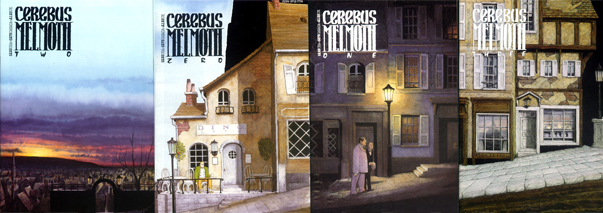
Much in the same way that Woody Allen’s Manhattan sought to make that film’s namesake a character in the movie, Gerhard really shines with the backgrounds here. There are some terrific slow tracking shots across the scenery, and some lovely wide shots that make you feel as if you’re sitting in the bushes watching the story happen in real time. But perhaps the most effective technique Gerhard employs is the soft encroachment of the white space into the panels’ real estate during the Wilde sequences, meant to represent Oscar’s clouded mind and his drifting in and out of consciousness. It’s quite moving, tremendously evocative, and even a little scary, especially as it gets close to tunnel vision. One can put oneself in Oscar’s place very easily, and that’s not a comfortable position to be in.
I’d like to make special mention of the logo for Melmoth, as it’s my favorite of all the books.
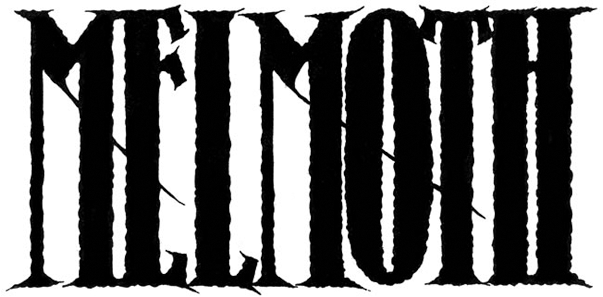
Top moments
Dave’s lettering of Oscar’s coughs
The fantastically cinematic tracking shots
“‘She’s the boss.’ Eh?”
Cerebus relenting and having an ale with his raw potato (NO butter, NO salt and pepper, NOT cut into sections, NOT on a plate)
Cerebus’ anger at not having a good morning wished to him
The panel timing while Cerebus’ has his sword to his own throat
For those who want to read along, the entire series is available as a digital download at Cerebus Downloads. (http://www.cerebusdownloads.com/index2v16s.html)
Cerebus re-read 2015–2016: Jaka’s Story
 I’ve been looking forward to this one big-time. The main reason I love Cerebus is that its scope is so huge. The focus (and sometimes the lack of it) and dedication of Dave and Ger is astounding, and the source of much of my admiration for them. I’ve always been into “big” projects. Even if they aren’t entirely successful, I still highly appreciate the guts that it took to produce the thing. I sometimes think of this series as the Sandinista! of comics. Warts & all.
I’ve been looking forward to this one big-time. The main reason I love Cerebus is that its scope is so huge. The focus (and sometimes the lack of it) and dedication of Dave and Ger is astounding, and the source of much of my admiration for them. I’ve always been into “big” projects. Even if they aren’t entirely successful, I still highly appreciate the guts that it took to produce the thing. I sometimes think of this series as the Sandinista! of comics. Warts & all.
It’s quite interesting, then, that in addition to crafting something so admirably gargantuan, this creative team also pulled off one of the greatest single volume graphic novels of all time (and my personal favorite, overall). Now, technically, it’s not quite a stand-alone, because it helps to understand why there’s a furry grey creature running around in a very small mountainside community…but it’s not essential to have that knowledge, and I think that one can enjoy Jaka’s Story as a single volume easier than they can High Society. This is helped by a very small cast of almost unknowns, the single setting (made up of three different buildings), and the fact that Cerebus doesn’t have much to do in the book aside from observe and maybe have ONE ale at the pub.
I’ve also been looking forward to this one because I don’t have to write as much of a detailed plot description. The nature of the writing is such that the story is a lot more about the relationships between the characters than it is about a chronology of events. It’s kind of like the kitchen sink drama of comics. Or the Kitchener sink drama. HAR!
After Cerebus returns from the moon, he begins walking down the Black Tower, probably feeling a little aimless (he’s going to “…die alone. Unmourned. And unloved,” remember?). He stops by a tavern positioned near some small cottages, and tries to pay the barman for ale with the single gold coin he has left. The barman basically flips out and tells Cerebus that he can’t possibly accept it. We find out a little later that after the Cirinists took over Iest and all of Cerebus’ gold, that its value has gone through the roof. While Cerebus is in the tavern, Jaka unexpectedly walks in. The two share a touching reunion, and it’s eventually decided that Cerebus will stay with Jaka and her husband, Rick Nash, for a time. It’s just the two of them, as Jaka reveals that she had a miscarriage, so the child she told Cerebus about in Church & State was never born. While living with the Nashes, most of Cerebus’ time is spent on an emotional rollercoaster every time the couple have an argument. He told Jaka that he would not be leaving without her, now that he has no responsibilities, and Jaka does not have a baby. Jaka shuts him down handily, but Cerebus is a stubborn one and also, doesn’t have anywhere else to go. Why not stick around and be tortured by seeing his unattainable love every day?
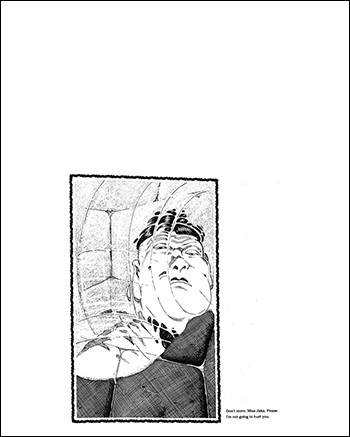 Rick turns out to be a lanky slugabed, albeit an unbelievable good-natured one. His outlook on life is unfailingly positive, and he is kind to all. However, he is beginning to feel neglected by Jaka, who quite understandably feels she has had to take on all the responsibility for their financial security. She is often cold, distant, and impatient with Rick, who makes periodic efforts to find a job, with no results. The barman that refused Cerebus’ gold is Pud Withers, who inherited from his mother the small plot of land upon which his bar and the two other cottages sit. The monetary advantage of his arrangement with Jaka is a little perplexing at the beginning: Jaka visits his shop every morning, refers to him as “Mr. Withers,” exchanges formal pleasantries, and pays him three copper bits for various fruits and nuts (which, more often than not, are out of season or rare). In the evenings, Jaka is employed as a dancer (her one passion) at his tavern, where she calls him “Pud,” and they have a much more casual relationship. As the tavern is secluded on the side of the Black Tower, they’ve been without customers since Jaka and Rick moved in. Regardless, Pud pays Jaka three copper bits (!) for her services, and the cycle repeats the next day. It’s obvious that Pud has the major hots for Jaka, and it’s revealed in some fairly dark conversations that he constantly rehearses in his mind that at a certain point, he’s going to find a way to get what he wants.
Rick turns out to be a lanky slugabed, albeit an unbelievable good-natured one. His outlook on life is unfailingly positive, and he is kind to all. However, he is beginning to feel neglected by Jaka, who quite understandably feels she has had to take on all the responsibility for their financial security. She is often cold, distant, and impatient with Rick, who makes periodic efforts to find a job, with no results. The barman that refused Cerebus’ gold is Pud Withers, who inherited from his mother the small plot of land upon which his bar and the two other cottages sit. The monetary advantage of his arrangement with Jaka is a little perplexing at the beginning: Jaka visits his shop every morning, refers to him as “Mr. Withers,” exchanges formal pleasantries, and pays him three copper bits for various fruits and nuts (which, more often than not, are out of season or rare). In the evenings, Jaka is employed as a dancer (her one passion) at his tavern, where she calls him “Pud,” and they have a much more casual relationship. As the tavern is secluded on the side of the Black Tower, they’ve been without customers since Jaka and Rick moved in. Regardless, Pud pays Jaka three copper bits (!) for her services, and the cycle repeats the next day. It’s obvious that Pud has the major hots for Jaka, and it’s revealed in some fairly dark conversations that he constantly rehearses in his mind that at a certain point, he’s going to find a way to get what he wants.
 The comic relief is supplied by the Nashes’ neighbor, Oscar. Charming, arrogant, and Wildean as his namesake, Oscar is a writer who rented his cottage from Pud’s mother when she was still alive. He periodically travels to Upper Iest to visit his publisher and appear at various social gatherings. Rick is constantly bowled over by Oscar’s stories, and Oscar derives great enjoyment from spending time with Rick, as well. Jaka and Pud, on the other hand, highly dislike his pomposity. Oscar returns the animosity toward Pud, but what only Rick knows is that Oscar’s newest work-in-progress is the story of Jaka’s youth, which Rick has been feeding him information on. “Jaka’s Story” the book appears throughout Jaka’s Story the graphic novel, in the form of columns of prose accompanied by a single image every few pages or so. It’s a fantastically effective and engaging way to bridge the gap between Jaka’s early years in Palnu and her current life in Iest, although as a writer, Oscar has had to pad out the story with some speculation. The only problem is that Oscar is having difficulty describing Jaka’s dancing. Having never seen her dance, he finds himself lacking in inspiration. He is eventually able to view her art in the tavern, as a newly-arrived customer has given Jaka the opportunity to dance. Oscar is captivated by her movement, and is sufficiently motivated to reveal that he would like to read from his new book, “Jaka’s Story,” which Jaka freaks out about. While he is at his house picking up his book, the tavern is descended upon by a cadre of Cirinists, who kill Pud and the random customer, and nearly do the same to Rick and Jaka until she evokes diplomatic immunity as Lord Julius’ niece. The two are carted off. Oscar arrives and is sentenced to two years hard labor for working as an author with no license. Cerebus, having gone to the lower city to obtain some paint, returns to find the mini-village ransacked and empty.
The comic relief is supplied by the Nashes’ neighbor, Oscar. Charming, arrogant, and Wildean as his namesake, Oscar is a writer who rented his cottage from Pud’s mother when she was still alive. He periodically travels to Upper Iest to visit his publisher and appear at various social gatherings. Rick is constantly bowled over by Oscar’s stories, and Oscar derives great enjoyment from spending time with Rick, as well. Jaka and Pud, on the other hand, highly dislike his pomposity. Oscar returns the animosity toward Pud, but what only Rick knows is that Oscar’s newest work-in-progress is the story of Jaka’s youth, which Rick has been feeding him information on. “Jaka’s Story” the book appears throughout Jaka’s Story the graphic novel, in the form of columns of prose accompanied by a single image every few pages or so. It’s a fantastically effective and engaging way to bridge the gap between Jaka’s early years in Palnu and her current life in Iest, although as a writer, Oscar has had to pad out the story with some speculation. The only problem is that Oscar is having difficulty describing Jaka’s dancing. Having never seen her dance, he finds himself lacking in inspiration. He is eventually able to view her art in the tavern, as a newly-arrived customer has given Jaka the opportunity to dance. Oscar is captivated by her movement, and is sufficiently motivated to reveal that he would like to read from his new book, “Jaka’s Story,” which Jaka freaks out about. While he is at his house picking up his book, the tavern is descended upon by a cadre of Cirinists, who kill Pud and the random customer, and nearly do the same to Rick and Jaka until she evokes diplomatic immunity as Lord Julius’ niece. The two are carted off. Oscar arrives and is sentenced to two years hard labor for working as an author with no license. Cerebus, having gone to the lower city to obtain some paint, returns to find the mini-village ransacked and empty.
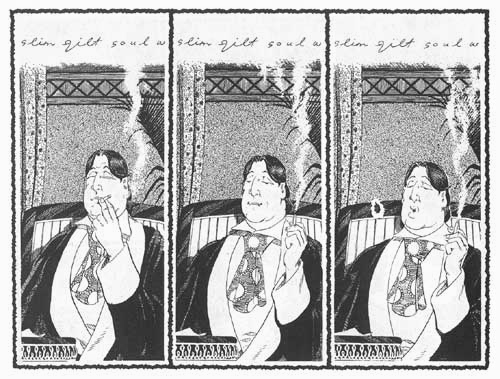
Jaka is held in a cell for a time, then released into a room more befitting her diplomatic status, where she is interviewed daily by a Mrs. Thatcher (you can guess the parody this time), who is a revoltingly condescending Cirinist of high ranking. She tries to pressure Jaka into admitting that dancing for men is WRONG, and that it causes lewd thoughts in their minds. She presents a newly shaven Rick, and proceeds to tell him that Jaka had actually aborted their child rather than having had a miscarriage. He becomes enraged when he finds it was to have been a boy, strikes Jaka and declares emphatically that he never wants to see her again. The two are separated, Rick to his mother’s, and Jaka back to Palnu.
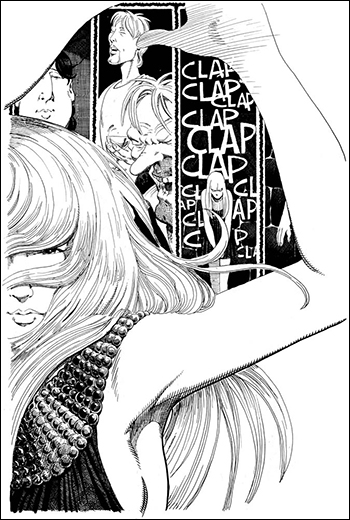 It’s difficult to find the words for how much I love this volume. I find it to be an achingly beautiful representation of the mundanity of long-term relationships. The rest of the story is at times humorous, tragic, and a little scary. We learn a lot about Jaka, though we’re not sure of the accuracy of Oscar’s reporting. How much of “Jaka’s Story” is the result of artistic license, or the dilution of Jaka’s stories told to Rick and relayed to Oscar? We don’t know, but one thing glaringly obvious. This is that Jaka must feel free, even at great cost. The parts of Oscar’s book that involve Jaka’s “nurse” do not correspond with what we know about the woman later in the volume, but in Jaka’s mind, the ever-presence of authority was clearly not well tolerated. This resulted in an injury while dancing in the playground as an attempt at a momentary sense of freedom, and also in Jaka’s disobedience in opening a forbidden door at her home in Palnu. If we weren’t aware of it before, we are now positive that Jaka views dance as the key to this freedom. This is a point driven excruciatingly home at the revelation of Jaka’s abortion, which was slightly foreshadowed in Church & State, when Jaka expressed her fears that having a baby would make her ugly. Being ugly, of course, would have been a detriment to her career, and therefore, not acceptable. Jaka chose freedom slightly thereafter, and here it costs her marriage. Now, whether Rick would have been more receptive to her fears if she had discussed them with him first is debatable. Rick mentions to Oscar earlier that if Jaka couldn’t dance anymore because of him, that she’d hate herself and he’d hate her. He notes that he’d “feel as if [our] love had destroyed something more important than either of [us]…” Would he have agreed that they shouldn’t have a child? Convinced her to have a child and resented her for it later, or convinced her NOT to have a child and resented her for it later?
It’s difficult to find the words for how much I love this volume. I find it to be an achingly beautiful representation of the mundanity of long-term relationships. The rest of the story is at times humorous, tragic, and a little scary. We learn a lot about Jaka, though we’re not sure of the accuracy of Oscar’s reporting. How much of “Jaka’s Story” is the result of artistic license, or the dilution of Jaka’s stories told to Rick and relayed to Oscar? We don’t know, but one thing glaringly obvious. This is that Jaka must feel free, even at great cost. The parts of Oscar’s book that involve Jaka’s “nurse” do not correspond with what we know about the woman later in the volume, but in Jaka’s mind, the ever-presence of authority was clearly not well tolerated. This resulted in an injury while dancing in the playground as an attempt at a momentary sense of freedom, and also in Jaka’s disobedience in opening a forbidden door at her home in Palnu. If we weren’t aware of it before, we are now positive that Jaka views dance as the key to this freedom. This is a point driven excruciatingly home at the revelation of Jaka’s abortion, which was slightly foreshadowed in Church & State, when Jaka expressed her fears that having a baby would make her ugly. Being ugly, of course, would have been a detriment to her career, and therefore, not acceptable. Jaka chose freedom slightly thereafter, and here it costs her marriage. Now, whether Rick would have been more receptive to her fears if she had discussed them with him first is debatable. Rick mentions to Oscar earlier that if Jaka couldn’t dance anymore because of him, that she’d hate herself and he’d hate her. He notes that he’d “feel as if [our] love had destroyed something more important than either of [us]…” Would he have agreed that they shouldn’t have a child? Convinced her to have a child and resented her for it later, or convinced her NOT to have a child and resented her for it later?
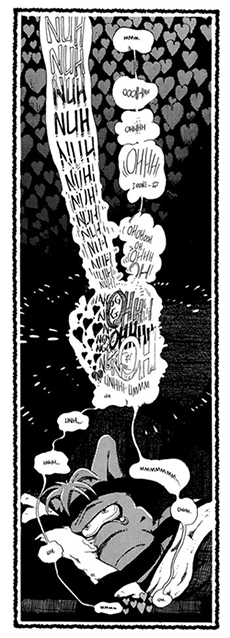 Dave’s pages of prose (written as Oscar) are simply stunning. Cleanly designed pages featuring a single column of text with a highly detailed drop cap next to a lovingly rendered image by Dave and Gerhard…who could complain? Well, I’m a designer, so I’m going to a little bit, just by mentioning that the full justification of the text is a little unruly, resulting in some lines with much more noticeable word spacing than others. Not a huge deal, but hard for my design-mind to ignore. Aside from that, it’s a great way to break up the paneled pages, which in this volume are mostly 3×2, 4×2, and 5×2. Not much interest in layout (though there are some choice pages), but that’s pretty much what’s called for in a story like this. It also makes the times when Dave does break the grid a little more powerful.
Dave’s pages of prose (written as Oscar) are simply stunning. Cleanly designed pages featuring a single column of text with a highly detailed drop cap next to a lovingly rendered image by Dave and Gerhard…who could complain? Well, I’m a designer, so I’m going to a little bit, just by mentioning that the full justification of the text is a little unruly, resulting in some lines with much more noticeable word spacing than others. Not a huge deal, but hard for my design-mind to ignore. Aside from that, it’s a great way to break up the paneled pages, which in this volume are mostly 3×2, 4×2, and 5×2. Not much interest in layout (though there are some choice pages), but that’s pretty much what’s called for in a story like this. It also makes the times when Dave does break the grid a little more powerful.
Dave has gotten a lot better at keeping his characters, especially women, on-model in this book as well. Nothing like drawing tons of Jaka to help you start drawing her really consistently, something that a female character like Astoria certainly hasn’t enjoyed up to this point. You can also see some Mort Drucker influence in the way Dave draws overall, especially in the chins. As for lettering, this book has one of my favorite examples of Dave’s creativity, as Cerebus is forced to listen to Jaka and Rick having sex on the other side of the wall. There’s some other fantastic examples throughout, and Dave’s ability to imply tone, volume, motion, and timing through hand-drawn type adds an atmosphere to Cerebus sorely lacking in many other comics, which seem comparatively flat and static. The character of Mrs. Thatcher is particularly expressive, foreshadowing how much more emphasis would be on lettering in the future. Gerhard’s work continues to improve, and he benefits from having fewer settings to worry about. This allowed him to further solidify his toning skills, giving great depth and life to Jaka’s Story. This adherence to a single setting would be further explored, to great success, with Melmoth.
Top Moments
Cerebus: “Listen. Kid. Cerebus is in love with your wife…”
Rick: “I know, she’s great, isn’t she?”
Jaka: “You do not, I rePEAT…do NOT ask a guest in my home to make APILLAROFFIRE!!
Rick: “I asked him IF he knew how!!! If! IF! IF!”
The look on Oscar’s face in the midst of his writer’s block
Oscar’s main altercation with Pud
Gerhard’s mind-blowing skill at drawing rain and mist
Jaka: “You bet your ASS, grampaw…”
Old man: “HOW’S THAT?!
Oscar [quietly]: “I said ‘they’re tainted with opium…'”
Old man: “Ye have ta SPEAK UP, SONNY!”
Oscar [louder]: “I said ‘they’re very good.'”
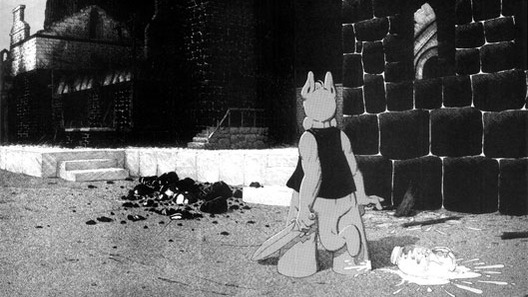
Cerebus re-read 2015–2016: Church & State II
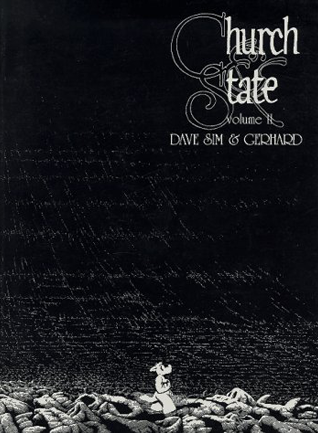 It’s tempting to review Church & State I & II as one work, which it technically is, but there’s definitely enough in this volume to warrant its own post. Aside from Dave and Ger really starting to combine forces in a breathtakingly impressive fashion, Dave’s writing is a total home run. He totally nails the dramatic structure in this second half of the story, but very fluidly. It’s become clear how valuable it is for Dave to have planned out so much of the book before writing it—so much thought has gone into it by this point that there’s nary a wasted line of dialogue or superfluous drawing. It’s all reaching toward a singular purpose with maximum efficiency and STILL manages to be staggeringly entertaining. I had to have a little chuckle to myself as I cracked open this volume…Dave normally writes a full-page foreword, and he noted in the foreword of volume I that readers following along only in the phonebooks would have to be patient for two years for this one. So, as Dave says in the very short volume II foreword, “Hey, don’t let me stop you.”
It’s tempting to review Church & State I & II as one work, which it technically is, but there’s definitely enough in this volume to warrant its own post. Aside from Dave and Ger really starting to combine forces in a breathtakingly impressive fashion, Dave’s writing is a total home run. He totally nails the dramatic structure in this second half of the story, but very fluidly. It’s become clear how valuable it is for Dave to have planned out so much of the book before writing it—so much thought has gone into it by this point that there’s nary a wasted line of dialogue or superfluous drawing. It’s all reaching toward a singular purpose with maximum efficiency and STILL manages to be staggeringly entertaining. I had to have a little chuckle to myself as I cracked open this volume…Dave normally writes a full-page foreword, and he noted in the foreword of volume I that readers following along only in the phonebooks would have to be patient for two years for this one. So, as Dave says in the very short volume II foreword, “Hey, don’t let me stop you.”
After Cerebus is hurled into lower Iest by his usurper, The Giant Stone Thrunk (aka Necross the haha Mad), he’s confronted by the Roach (now a parody of black-costume Secret Wars Spider-Man), who reveals that he’s preparing for the Secret Sacred Wars, which amounts to trying to dethrone Thrunk (“Epop”). Cerebus then gets transported without warning by the Big Round Glowing White Strange Thing, first to another dimension where he’s told about “The Final Ascension,” then to Countess Michele’s much smaller house in the lower city. She details her history with Weisshaupt, and reveals that Weisshaupt had chosen Cerebus to take his place as Tarim on earth in the event of Weisshaupt’s death. Michele gives him a packet, which contains a message from Weisshaupt: a picture of one of the cannons that Weisshaupt had set up across from Cerebus’ hotel when he tried to take all the gold Cerebus had amassed last volume. Cerebus gets the message and sets off back up the Black Tower to the upper city to get back his papacy (but not before running into a hilarious parody of Mick Jagger and Keith Richards). The Roach begins climbing the tower in order to confront Thrunk, and Cerebus follows. Astoria had been waiting at the top for the Roach, who pushes her aside in his determination to kill the false pope. Cerebus follows shortly after, yelling at Astoria to GO AWAY when she tries to stop him. She inexplicably dissolves into thin air at this command. The Roach is kicked back into the lower city by Thrunk, but Cerebus is able to utilize the cannons and the last moment (and one of the best sequences of the entire series) and kills Thrunk.
Cerebus returns to his hotel and is immobilized by the Big Round Glowing White Strange Thing, which returns him to the previously-seen dimension. There he speaks to Suenteus Po, who outlines his previous lives’ failed attempts to take part in The Final Ascension (it turns out you need to hold a sphere of purest gold on TOP of the Black Tower. Not next to it, inside it, or across the river from it). Cerebus is released from the dimension to find that the Lion of Serrea (the pope of the Western Church) has been assassinated, and that Cerebus needs to sentence the perpetrator, who is revealed to be Astoria. Cerebus commands Bishop Powers to find someone to make a gold sphere for him, and leaves to question Astoria, who’s chained in a prison cell. She freely admits to the assassination, and asserts that Cerebus owes her for his current position, having helped him rise to power in High Society. Cerebus balks at this, so Astoria tries another tactic. She offers to have sex with him if he grants her a favor afterward, but then teasingly rescinds the offer, reminding him that as an orthodox Tarimite, he can’t have sex out of wedlock. Cerebus gags Astoria, declares the two married, rapes her, and falls asleep. When he wakes, he ungags Astoria and she speaks to him about The Final Ascension, asking what he would say to Tarim (or, “Terim,” as she says—the female version of the deity), making it clear that Cerebus is not worthy, and that a woman will be the one to successfully ascend. She then outlines for him all of the ways that her fate could play out, the most important of which is that if he sentences her to death, Cirin will descend on Iest with her troops and kill Cerebus, having reserved the pleasure of killing Astoria for herself. It’s decided that the best option is for Cerebus to break Astoria out and then allow himself to be knocked out. He would then absolve himself of any responsibility to either the church or Cirin. However, before Cerebus can break her chains, Powers returns to inform him that the gold sphere had some imperfections and is being recast, and to take him to the throne room to prepare for the trial.
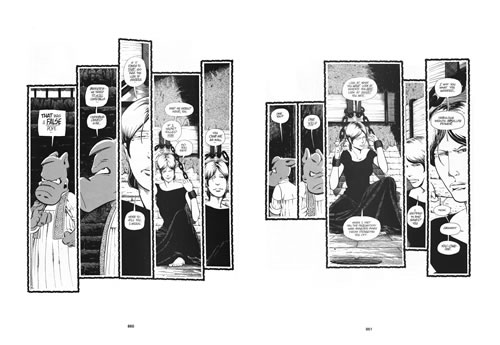
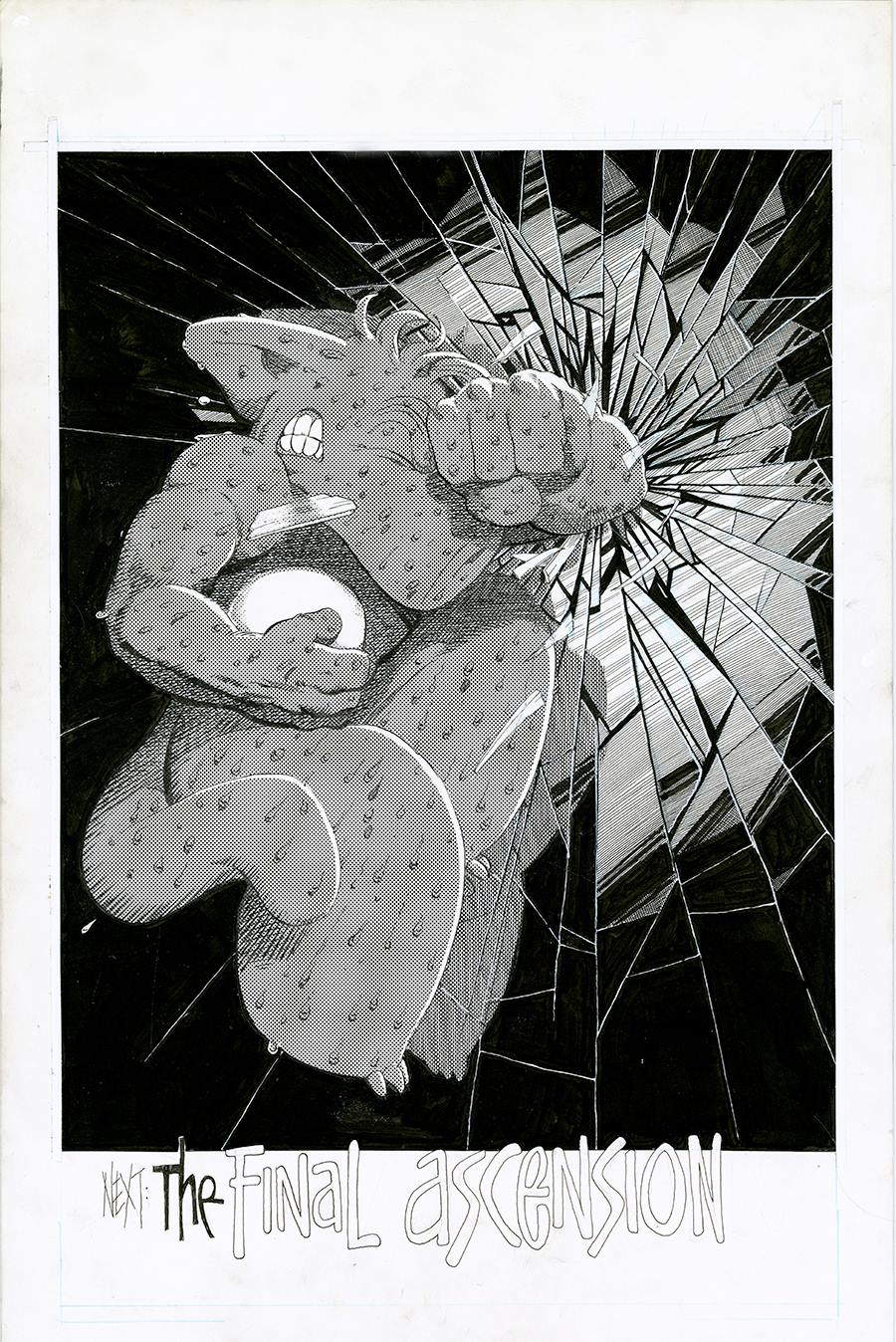 Astoria reveals at the trial that when she dissolved after Cerebus told her to GO AWAY, she reappeared in front of the Lion of Serrea, seemingly mid-argument. She killed him with a nearby knife, as though she were compelled to do so. After some bang-up dialogue and illusions that may be sorcery, Cerebus washes his hands of the matter. Meanwhile, Cirin gets news of the trial and orders her troops to mobilize for the invasion of Iest. When we finally see her face, it’s revealed that she is one of the two other aardvarks in Estarcion that Weisshaupt mentioned. Cerebus finds a box at the foot of his throne’s platform, seemingly just having appeared from nowhere. He opens it to find a gold sphere and a note: “Good luck. –W.” He grabs the sphere and bolts for one of the windows, jumping through it to the interior wall of the vertically growing Black Tower outside. The excess tower detaches from its base and heads toward the moon faster than sound, Cerebus hanging on for dear life. When he’s deposited on the moon he’s met by a man in judge’s robes, who calls himself “The Judge,” who claims to see all and to know all. He tells Cerebus that he will NOT conquer the known world, though he came close. He also lets it be known that the moon is NOT heaven, and that he is NOT Tarim. He then goes on to detail the origin of the universe.
Astoria reveals at the trial that when she dissolved after Cerebus told her to GO AWAY, she reappeared in front of the Lion of Serrea, seemingly mid-argument. She killed him with a nearby knife, as though she were compelled to do so. After some bang-up dialogue and illusions that may be sorcery, Cerebus washes his hands of the matter. Meanwhile, Cirin gets news of the trial and orders her troops to mobilize for the invasion of Iest. When we finally see her face, it’s revealed that she is one of the two other aardvarks in Estarcion that Weisshaupt mentioned. Cerebus finds a box at the foot of his throne’s platform, seemingly just having appeared from nowhere. He opens it to find a gold sphere and a note: “Good luck. –W.” He grabs the sphere and bolts for one of the windows, jumping through it to the interior wall of the vertically growing Black Tower outside. The excess tower detaches from its base and heads toward the moon faster than sound, Cerebus hanging on for dear life. When he’s deposited on the moon he’s met by a man in judge’s robes, who calls himself “The Judge,” who claims to see all and to know all. He tells Cerebus that he will NOT conquer the known world, though he came close. He also lets it be known that the moon is NOT heaven, and that he is NOT Tarim. He then goes on to detail the origin of the universe.
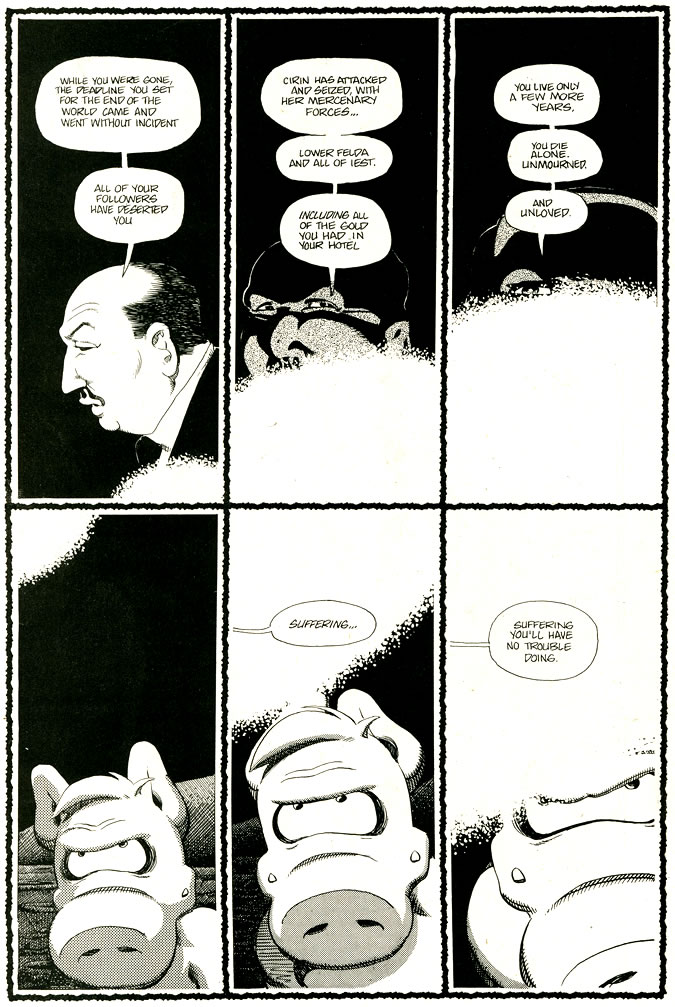 In the beginning there was the void, and the void was Tarim. Suddenly, Terim appeared as a pinpoint of light. Tarim, in his curiosity, exerted extensive “pressure” on the light in an attempt to know it better, to see what it was like inside, which caused Terim to split in two, explode, and die. Stars, planets and other celestial bodies are revealed to be the remains of Terim’s corpse, and Tarim just sits around, lonely, and hosts the dead parts of the only other being to exist in his vicinity. The Judge then looks to the future, where he outlines an unnamed culture’s attempts to hold the earth hostage by threatening to explode the sun. They do so, and aside from some blue-green fungus down the line, that’s it for life in this solar system. Cerebus learns that in his absence, Cirin has taken over Iest. The Judge reveals that Cerebus will live only a few more years, and will die alone, unmourned and unloved. He asserts that if Cerebus ever considers his suffering unjustified, that he should just recall his second marriage (a reference to his raping of Astoria). He then returns Cerebus to his hotel on the side of the Black Tower, which has been ransacked by Cirinist troops. His gold taken and followers dispersed, Cerebus attempts suicide by leaping down the tower, but chickens out. He begins walking down the tower toward the lower city.
In the beginning there was the void, and the void was Tarim. Suddenly, Terim appeared as a pinpoint of light. Tarim, in his curiosity, exerted extensive “pressure” on the light in an attempt to know it better, to see what it was like inside, which caused Terim to split in two, explode, and die. Stars, planets and other celestial bodies are revealed to be the remains of Terim’s corpse, and Tarim just sits around, lonely, and hosts the dead parts of the only other being to exist in his vicinity. The Judge then looks to the future, where he outlines an unnamed culture’s attempts to hold the earth hostage by threatening to explode the sun. They do so, and aside from some blue-green fungus down the line, that’s it for life in this solar system. Cerebus learns that in his absence, Cirin has taken over Iest. The Judge reveals that Cerebus will live only a few more years, and will die alone, unmourned and unloved. He asserts that if Cerebus ever considers his suffering unjustified, that he should just recall his second marriage (a reference to his raping of Astoria). He then returns Cerebus to his hotel on the side of the Black Tower, which has been ransacked by Cirinist troops. His gold taken and followers dispersed, Cerebus attempts suicide by leaping down the tower, but chickens out. He begins walking down the tower toward the lower city.
No bones about it, this book is a serious masterpiece, especially when combined with Volume I. I mentioned before that Dave’s writing is masterful by this point. The four or so issues that comprise Astoria’s trial contain some of the tensest moments in fiction, and some of the most natural dialogue in comics. It’s paced incredibly effectively and facilitates some great edge-of-your-seat reading, even on my fourth run-through. The paneling in this volume is also quite interesting. During Cerebus and Astoria’s confrontation in the prison cell and for some of the trial, Dave utilizes a ton of white space, which surrounds a number of very thin panels in the center of the page. This adds a feeling of claustrophobia, tension, and helps to create a certain amount of urgency in the dialogue. It’s pretty ingenious in design really, and shows an immense command of storytelling. By allowing the reader to read from left to right, rather than having to read a top row of panels and then direct the eye back to the left for the bottom row of panels, Dave creates a real sense of momentum, which, when integrated with the subject matter, is damned compelling.
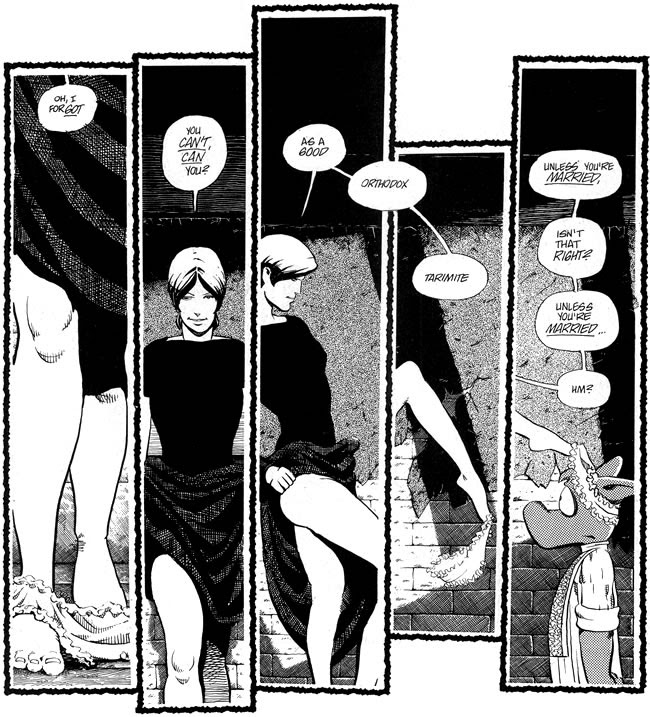
We begin to see in this volume what is later termed Cerebus’ “magnifier effect.” In moments of great energy, tension, or consequence, it seems that Cerebus can unwittingly be a catalyst for some monumental events, such as causing Astoria to disappear or causing the Black Tower to grow as he gets closer to obtaining a gold sphere (though this may just be related to the Ascension itself, rather than to Cerebus specifically). This will come to play a large role in Mothers & Daughters, but it also explains his ability to command an enormous group of people without having much charisma on his side.
Gerhard, too, does some very impressive work here. His depiction of the moon alone is worthy of an Eisner. On top of that, the incredible textures he’s able to squeeze out of stone, fabric, and glass show a remarkable understanding of light and shadow, perspective, and tone. In an extremely short time, he’s corrected any lingering obstacles to making his and Dave’s work look integrated. It’s so refined by this point that you might be surprised to read that it only improves from here. I can’t imagine how much work it would have taken to draw the faces of the Black Tower so many times, but Ger is an incredible artist, and none of it looks phoned-in or glossed over. He gave 100% to every page, so it’s not hard to see how he wound up with chronic stomach pains near the end of the series. He’s better now, and we’re better for his contributions to the world of not just comics, but art itself. Gerhard’s task would be a bit less intensive over the next 12 issues, as we spend the entire following storyline in one small plot of land on the side of the Black Tower in Jaka’s Story.
Top Moments
Cerebus’ dustpan lesson
“We’re all plants…Cerebus can feel it…”
Page 750. Just read the book.
Talking about Heaven with Po
Cerebus: “Will Cerebus still be able to drink?”
Po: “I don’t know. I guess so. It’s hard to tell. Probably you’d be able to drink but you wouldn’t want to.”
Cerebus: “Why?”
Po: “Well, because everything will be perfect and you’ll feel good without drinking…”
Cerebus: “Cerebus doesn’t drink to feel good…Cerebus drinks because he likes drinking…”
Po: “I’m not really the one to ask. I don’t know. Maybe you’ll be able to drink but you won’t get hangovers.”
Cerebus: “That sounds more like it.”
Fred lip-synching with the artist chap
For those who want to read along, the entire series is available as a digital download at Cerebus Downloads.
Cerebus re-read 2015–2016: Church & State I
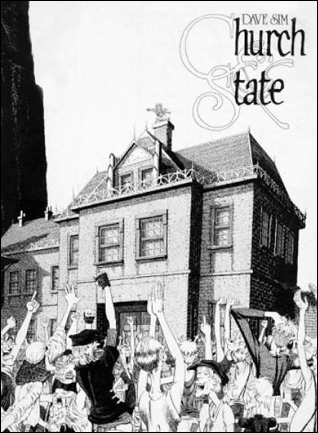 Many years ago, when I first saw Dave on that “Masters of Comic Book Art” VHS, the Church & State storyline had either just finished or was wrapping up soon. As such, a large part of (my memory of) the documentary focused on that storyline. The idea of a comic about a 3-foot aardvark becoming a prime minister and then the pope almost blew my 11-year old mind, after it had atrophied from years of reading about superheroes. It seemed such a unique and interesting idea, and of course Dave described his creation so persuasively that I asked for Volume 1 for Christmas that year. When I finally made it up to Volume 3 (C&S I), I was so excited to read what I had been pulled in by, and boy did Dave make good on his promise. This volume also sees Gerhard join Dave in issue #65, providing backgrounds and boosting the artistic quality by some measurement that I can’t even fathom. Gerhard would stick it out until the conclusion of the series with issue #300 as part of one of the greatest artistic collaborations of all time.
Many years ago, when I first saw Dave on that “Masters of Comic Book Art” VHS, the Church & State storyline had either just finished or was wrapping up soon. As such, a large part of (my memory of) the documentary focused on that storyline. The idea of a comic about a 3-foot aardvark becoming a prime minister and then the pope almost blew my 11-year old mind, after it had atrophied from years of reading about superheroes. It seemed such a unique and interesting idea, and of course Dave described his creation so persuasively that I asked for Volume 1 for Christmas that year. When I finally made it up to Volume 3 (C&S I), I was so excited to read what I had been pulled in by, and boy did Dave make good on his promise. This volume also sees Gerhard join Dave in issue #65, providing backgrounds and boosting the artistic quality by some measurement that I can’t even fathom. Gerhard would stick it out until the conclusion of the series with issue #300 as part of one of the greatest artistic collaborations of all time.
After Cerebus loses the title of Prime Minister of Iest, he travels through New Sepra, writing his memoirs, which are some of the funniest things I’ve ever read and very true to character. Dave really had this little guy figured out by this point. He then stays as a houseguest of Countess Michelle while he continues to write. Weisshaupt reappears (he’s known Michelle for some time) and reveals that he’s finally gotten the support of the city-states bordering the Feld River to join as the United Feldwar States, with Weisshaupt as President. He wants Cerebus to reassume leadership of Iest, but Cerebus has had enough of politics. Cerebus and Michelle’s relationship takes a downward slide due to outside influences and Cerebus heads off on a bender. He awakens the next morning to find that Weisshaupt has drugged him, and that he got married to Red Sophia (from issue #3) while under the influence. As he can’t divorce her without some…difficulty, he agrees to Weisshaupt’s terms and returns to Iest to stand as a puppet Prime Minister.
During his time in office, Cerebus is called to visit the pontiff of the Eastern Church of Tarim, who is assassinated before his eyes, seemingly for being a Cirinist. Bishop Powers demands that Weisshaupt supply a candidate for the next pontiff, but Weisshaupt and Powers clearly hate one another, and Weisshaupt plays coy on the issue. Powers’ hand is forced and he tries to get one over on Weisshaupt by nominating Cerebus.
 Normally, the pontiff of the Eastern Church would reside in Iest’s upper city, but Cerebus has other plans and holes up in a hotel on the side of the tower upon which the upper city sits. He begins referring to himself as “Most Holy,” hires a couple of bodyguards (Bear and Boobah), and becomes drunk on power—an acquired taste from his Prime Minister days, and a quality that sees him descend from a crotchety talking animal to a bit of a reprehensible monster. He regularly climbs to the roof of his hotel to address his followers by telling them that Tarim is not pleased with them, and alerts them that if they don’t bring all their gold to Cerebus, that Tarim will destroy the world. This works predictably well, and Cerebus amasses quite a stock of gold. He also throws babies across the courtyard and kicks old men off the roof, both as some sort of lesson about life. Red Sophia eventually leaves him due to his behavior, and Cerebus calls for Jaka. She arrives at the hotel and reveals that she’s now married and pregnant. Cerebus tries to get her to leave with him, but she declines, feeling a duty to her child and husband. She returns to the lower city, and Cerebus gets word that Weisshaupt is dying. Cerebus goes to see him and in some of his last words, Weisshaupt reveals that there are two other aardvarks in Estarcion, and that he sees in a near-death vision that Cerebus, not Weisshaupt, is truly the chosen one. Cerebus returns to the hotel, and is confronted by the giant stone Thrunk (really a sorcerer who had implanted his consciousness in a huge statue in issue #13), who appoints himself the new pope, and chucks Cerebus down the tower into the lower city.
Normally, the pontiff of the Eastern Church would reside in Iest’s upper city, but Cerebus has other plans and holes up in a hotel on the side of the tower upon which the upper city sits. He begins referring to himself as “Most Holy,” hires a couple of bodyguards (Bear and Boobah), and becomes drunk on power—an acquired taste from his Prime Minister days, and a quality that sees him descend from a crotchety talking animal to a bit of a reprehensible monster. He regularly climbs to the roof of his hotel to address his followers by telling them that Tarim is not pleased with them, and alerts them that if they don’t bring all their gold to Cerebus, that Tarim will destroy the world. This works predictably well, and Cerebus amasses quite a stock of gold. He also throws babies across the courtyard and kicks old men off the roof, both as some sort of lesson about life. Red Sophia eventually leaves him due to his behavior, and Cerebus calls for Jaka. She arrives at the hotel and reveals that she’s now married and pregnant. Cerebus tries to get her to leave with him, but she declines, feeling a duty to her child and husband. She returns to the lower city, and Cerebus gets word that Weisshaupt is dying. Cerebus goes to see him and in some of his last words, Weisshaupt reveals that there are two other aardvarks in Estarcion, and that he sees in a near-death vision that Cerebus, not Weisshaupt, is truly the chosen one. Cerebus returns to the hotel, and is confronted by the giant stone Thrunk (really a sorcerer who had implanted his consciousness in a huge statue in issue #13), who appoints himself the new pope, and chucks Cerebus down the tower into the lower city.
The characters and events in this book are extremely important to the rest of the series. The most valuable piece of information is that Cerebus may actually be somehow special, aside from being a short grey aardvark in a world of humans. Weisshaupt’s deathbed vision foreshadows, though not entirely accurately, some events and revelations that will take place in volumes 7–10. Jaka continues to be an influential presence in Cerebus’ life, which will come to a bit of a head in volume 5, and again in volumes 13–14. This is also the beginning of the “Something Fell” theme, which crops up again and again, but is unfortunately never fully explained. This volume also marks the return of supernatural forces unseen since the earlier days of Cerebus (if you don’t count the Regency Elf). Between the ghost of Charles X. Claremont inhabiting the body of the Roach (I just realized I haven’t covered this character yet. In a nutshell, he’s a whackjob who fancies himself a superhero, either choosing a new identity or having it chosen for him roughly each volume. He’s very easily manipulated and stands in as a parody of superhero comics. In this volume he is the Wolverroach, a pawn of Weisshaupt’s), the Big Round Glowing White Strange Thing, and the resulting ability of Cerebus’ to shoot fire from his snout when he sneezes, there’s plenty of fantasy elements to go around.

This is the volume that I think Dave started to become a bit of a graphic designer. His layouts (especially page 1 splashes) became way more stylish, and his typography and lettering were even more so. He began to use typesetting in addition to hand lettering, which lent an appealing crispness to many kitchen-based sound effects, and his sense of scale, position, and negative space were very pleasing to the eye. He also had gotten much better at drawing women by this point, something that I think had been a bit of a struggle for him in previous volumes. In High Society, Astoria could often be off model, depending on what angle he was drawing her from, but he’s a lot more confident at this point with Sophia and Jaka. His skill at drawing characters would only improve as time went on now that he had teamed up with Gerhard and could take his mind off of backgrounds.
 Dave and Gerhard met at a party at Gerhard’s, where Dave saw some of Ger’s art and asked him if he’d like to collaborate on some color short stories that Dave had been approached to create for Epic. They turned out well, so Dave asked if he’d like to come on board for the monthly series, and the rest is history. Gerhard would go on to beautifully illustrate Estarcion around Dave’s characters. It’s a wonder to me that he never wound up with any sort of repetitive stress injury, as his work is so intricate and full of precise crosshatching and tone—you’d think he would have at least cramped up a lot. His work added immense depth to the world of Cerebus and as I mentioned before, turned a great comic into something truly extraordinary. His contribution cannot be understated. The “Odd Transformations” issues (below) were an exceptional piece of work, as it required Cerebus to interact with the landscape, so it was the first true test of this working relationship, and it paid off quite nicely. Church & State II would see further strengthening of this partnership and the levels of quality reached were as high as the moon.
Dave and Gerhard met at a party at Gerhard’s, where Dave saw some of Ger’s art and asked him if he’d like to collaborate on some color short stories that Dave had been approached to create for Epic. They turned out well, so Dave asked if he’d like to come on board for the monthly series, and the rest is history. Gerhard would go on to beautifully illustrate Estarcion around Dave’s characters. It’s a wonder to me that he never wound up with any sort of repetitive stress injury, as his work is so intricate and full of precise crosshatching and tone—you’d think he would have at least cramped up a lot. His work added immense depth to the world of Cerebus and as I mentioned before, turned a great comic into something truly extraordinary. His contribution cannot be understated. The “Odd Transformations” issues (below) were an exceptional piece of work, as it required Cerebus to interact with the landscape, so it was the first true test of this working relationship, and it paid off quite nicely. Church & State II would see further strengthening of this partnership and the levels of quality reached were as high as the moon.
Top Moments
Cerebus writing a sizable passage about Lord Julius’ leadership style, and concluding it with “He also has a painted-on mustache instead of a real one.”
Cerebus: “What did you say your name was…?”
Posey: “Archbishop Posey—just like the flower m-HUH m-HUH…I hope my base levity doesn’t offend you, Most Holy…”
“Spike’s a good dog…”
Next: That farmer guy from the “wuffa wuffa wuffa” issue
Cerebus trying to sneeze fire on Sophia’s mother only to have the power fail him at the last second.
For those who want to read along, the entire series is available as a digital download at Cerebus Downloads.
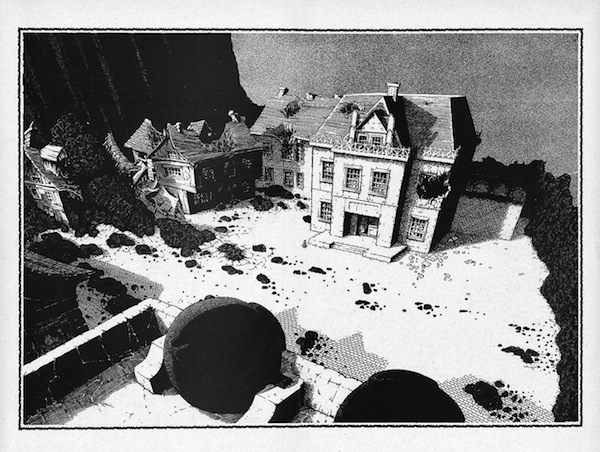
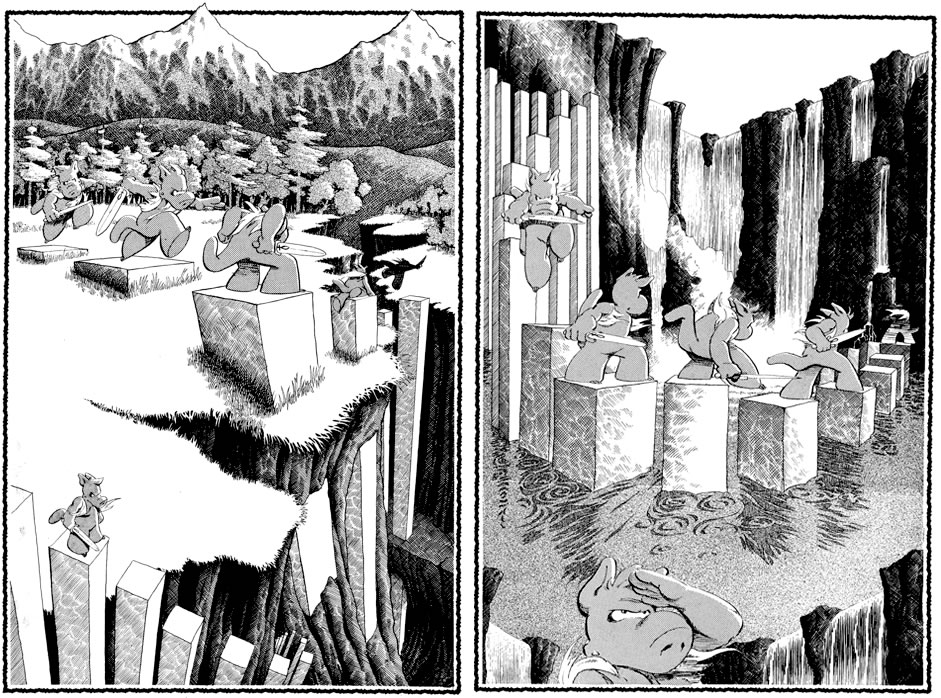

Recent Comments